Home Decor
Proven Techniques to Achieve a Clutter-Free Scandinavian Entryway
You'll discover essential tips and tricks to transform your entryway into a serene Scandinavian haven—stay tuned for the secrets!
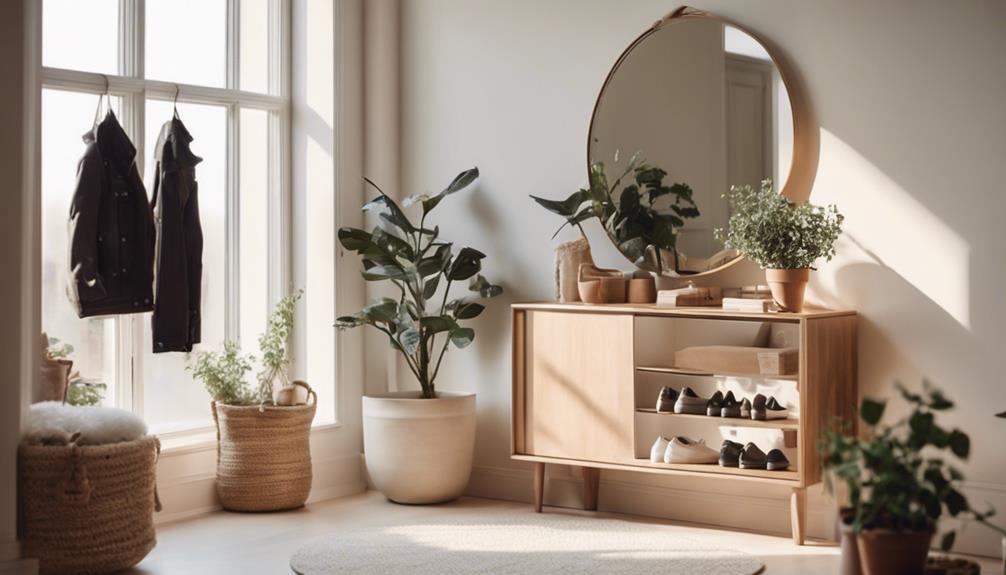
To create a clutter-free Scandinavian entryway, start with a neutral color palette that promotes calmness. Use functional furniture like sleek coat racks and wall-mounted shoe organizers to maximize space. Incorporate natural materials, such as light wood and soft textiles, to add warmth. Soft lighting, like pendant lights and wall sconces, enhances the cozy atmosphere. Don't forget decorative elements like handwoven tapestries or plants for a personal touch. Ultimately, consider eco-friendly flooring options like cork or bamboo to tie it all together. For more insights on achieving this serene style, you won't want to miss what comes next.
Key Elements
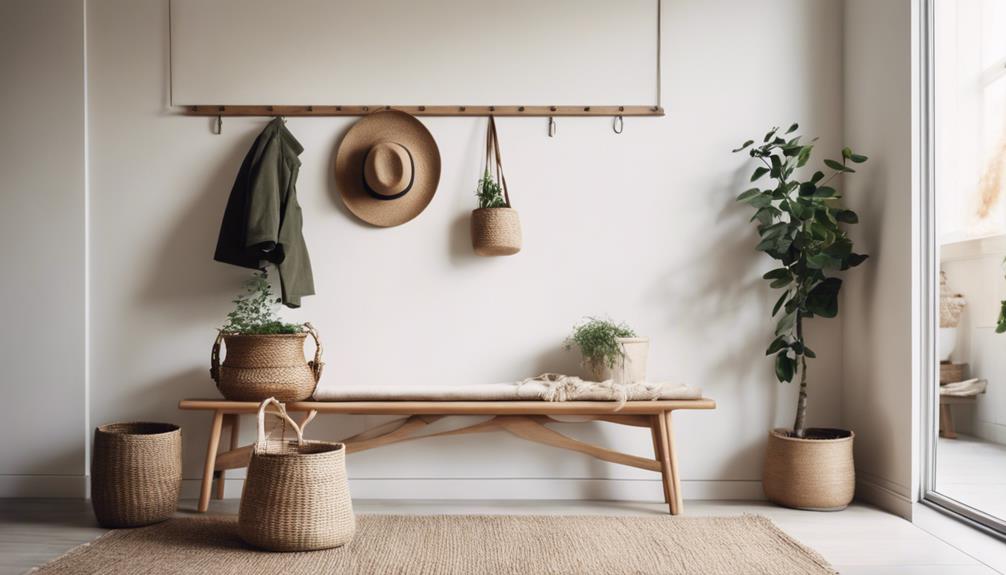
When creating your clutter-free Scandinavian entryway, focus on your color scheme, materials, and textures.
Choose a neutral palette and natural materials to foster a calm environment.
Color Scheme
Embracing a neutral color palette with shades of white, beige, and pale pastels sets the foundation for a bright and inviting Scandinavian entryway, promoting a sense of calm and spaciousness. This approach is essential to Scandinavian design, creating a clutter-free space that feels open and airy. When you choose monochromatic elements, each piece harmonizes with the overall aesthetic, ensuring a cohesive look that doesn't overwhelm the senses.
You can also introduce bold accents in a controlled manner to add character without detracting from the simplicity that defines Scandinavian decor. Light wood tones in your flooring and furniture enhance warmth and establish an organic connection to nature, core principles of this design style.
To elevate your entryway further, soft lighting is vital. Use fixtures and maximize natural light to complement your color scheme, fostering a cozy atmosphere that invites relaxation and comfort.
Materials
Natural materials like wood, stone, and textiles play an essential role in crafting a warm and inviting Scandinavian entryway that reflects a connection to nature. Using light wood flooring not only enhances the space's open and airy feel but also establishes a bright environment that promotes a seamless connection to the outdoors. When selecting materials, consider incorporating stone elements, which add an organic touch and durability to your entryway.
Textiles such as wool and linen are fundamental for providing comfort and softness, harmonizing beautifully with the minimalist aesthetic. These materials can be used in items like cushions or throw blankets, adding a welcoming feel without overwhelming the space.
Opting for a neutral color palette is critical in achieving a cohesive and uncluttered look. Whites, beiges, and light greys work together to create a calm atmosphere, allowing your choice of natural materials to shine.
Don't forget to incorporate indoor plants, which not only enhance the entryway's aesthetic but also improve air quality. By thoughtfully selecting materials that reflect the Scandinavian ethos, you can create an entryway that's both functional and inviting.
Textures
Incorporating a variety of textures in your Scandinavian entryway not only enhances its cozy atmosphere but also adds visual interest while keeping the space clutter-free.
Start with soft wool rugs and linen curtains to create a warm, inviting feel typical of Scandi design. Light wood accents in furniture, such as a storage bench, bring a natural touch that balances minimalism with tactile elements.
Layer different materials to add depth; smooth surfaces combined with textured fabrics create a harmonious look. Consider using baskets made from natural fibers like jute or cotton. They not only serve as practical storage solutions for shoes and accessories but also introduce organic textures that enrich your entryway.
Don't forget to soften hard surfaces! A plush throw on your bench can make the space feel welcoming and comfortable, reflecting the Scandinavian ethos of hygge.
Essential Fixtures and Furniture
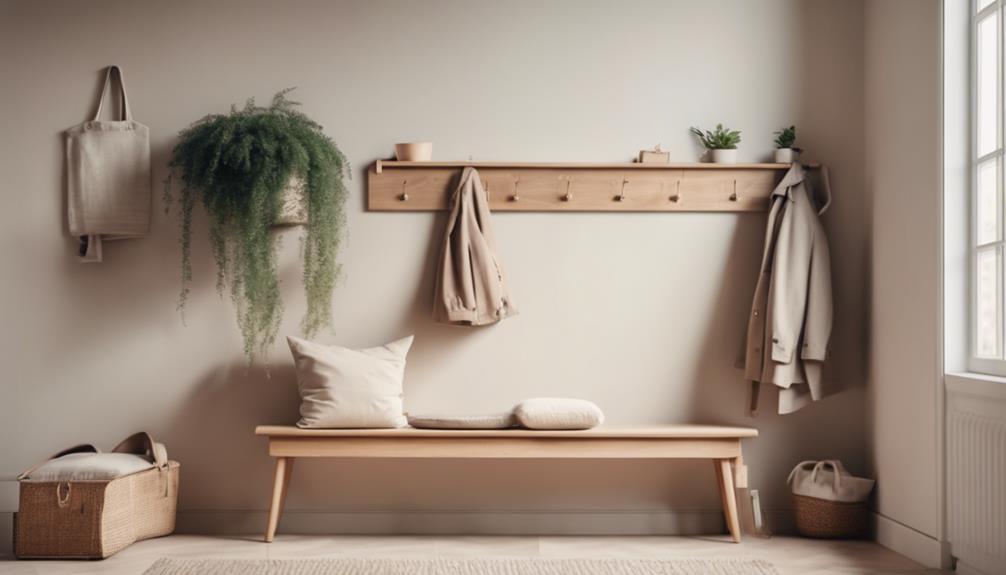
To create a clutter-free Scandinavian entryway, you'll need essential fixtures and furniture that enhance both function and style.
A sleek coat rack, compact storage ottoman, and wall-mounted shoe organizer are key pieces that keep your space tidy and organized.
Sleek Scandinavian Coat Rack
A sleek Scandinavian coat rack combines functionality with style, making it an essential fixture for a clutter-free entryway. These racks often feature clean lines and a minimalistic design that emphasizes practicality while enhancing your space's aesthetic appeal. Crafted from natural materials like wood or metal, they promote durability and create a warm, inviting atmosphere in your home.
Functional designs include hooks for hanging coats and bags, along with integrated storage solutions like shelves or benches to help reduce clutter. For instance, options like the O&K Furniture Hall Tree or eHome Products Entryway Shoe Bench combine coat racks with storage benches, maximizing space efficiency, especially in smaller entryways.
When choosing a coat rack, consider those with a neutral color palette. This aligns with Scandinavian principles, creating a cohesive and calming entryway environment. By incorporating a sleek Scandinavian coat rack, you not only streamline your storage but also elevate the overall look of your home.
Embrace this essential piece to keep your entryway organized and stylish, ensuring it remains a welcoming space for you and your guests.
Compact Storage Ottoman
The compact storage ottoman acts as a stylish solution for your entryway, providing both extra seating and hidden space for shoes and other essentials. This multifunctional piece of furniture helps you with decluttering and organizing, making your space feel more open and inviting.
Designed with the Scandinavian aesthetic in mind, many ottomans feature neutral colors and simple lines, ensuring they blend seamlessly into your decor. With a weight capacity of 200 to 300 pounds, you can rely on these sturdy ottomans for daily use without compromising style.
Plus, their average price range of $40 to $150 makes them an affordable addition to your entryway setup. You'll find a variety of materials like faux leather, fabric, and wood, allowing you to choose one that fits your personal taste.
Many models come with removable tops and interior compartments, providing customizable organization tailored to your specific storage needs. Whether you need a place for umbrellas, shoes, or other essentials, the compact storage ottoman is a practical and chic choice to enhance your entryway's functionality while maintaining a clutter-free atmosphere.
Wall-Mounted Shoe Organizer
Incorporating a wall-mounted shoe organizer elevates your entryway's organization, effectively utilizing vertical space to keep shoes off the floor and maintain a clutter-free aesthetic. This essential fixture not only maximizes functionality but also aligns perfectly with Scandinavian design principles that prioritize simplicity and minimalism.
With multiple compartments or shelves, a wall-mounted shoe organizer accommodates various shoe sizes and styles, making it easy for your family to find and access their footwear. This streamlined approach reduces tripping hazards and promotes a tidy environment, enhancing your overall home organization.
Opt for options like the Umbra Shoe Rack with Hooks or the closetMaid Wall-Mounted Shoe Organizer, which not only manage shoes well but also add a stylish touch to your entryway.
Many of these organizers are crafted from natural materials or eco-friendly composites, reflecting a commitment to sustainability that's central to Scandinavian aesthetics.
Lighting Ideas
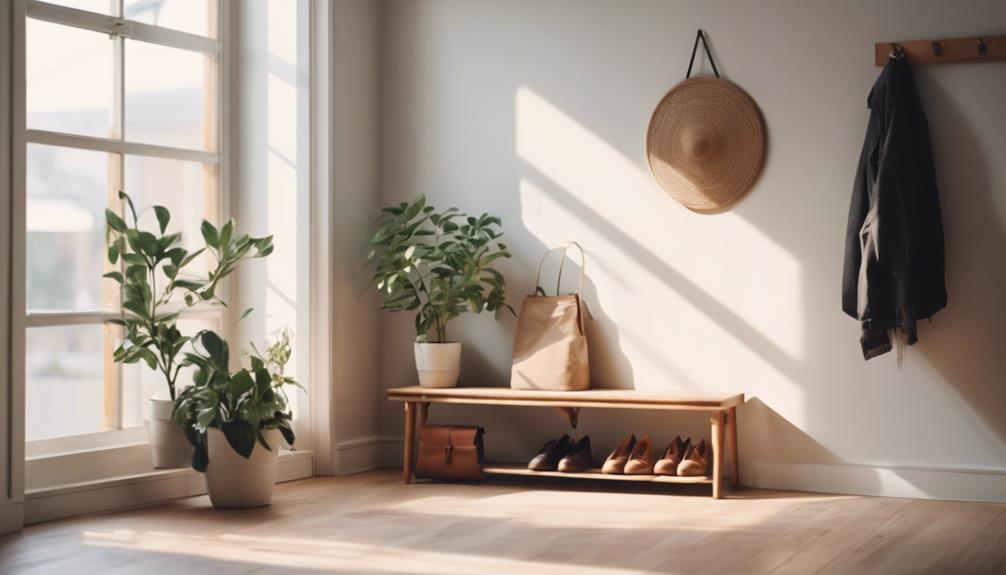
When it comes to lighting your Scandinavian entryway, think about using pendant lights made from natural materials to create a welcoming glow.
Wall sconces with a soft glow can add warmth, while recessed LED ceiling lights keep the look sleek and modern.
Don't forget a natural fiber table lamp to enhance the cozy vibe and bring everything together.
Pendant Light With Natural Materials
Pendant lights crafted from natural materials like wood and rattan not only bring warmth to your Scandinavian entryway but also enhance its inviting charm. These materials add texture and align perfectly with the Scandinavian aesthetic, which emphasizes simplicity and functionality. Opt for light-colored wood or neutral tones that complement the typical color palette found in Scandinavian designs, creating a serene atmosphere.
Hanging pendant lights at varying heights can create visual interest while maximizing natural light, making your entryway feel airy and spacious. This approach not only highlights the beauty of the pendant lights but also serves a practical purpose, ensuring adequate illumination for safety and functionality.
Consider incorporating energy-efficient LED bulbs in your pendant lighting. This choice not only reduces energy consumption but also reflects the sustainable design practices that are a hallmark of Scandinavian homes.
A well-placed pendant light can serve as a focal point, enhancing the overall design of your entryway while keeping it clutter-free. By choosing pendant lights made from natural materials, you'll create an inviting space that embodies both style and practicality.
Wall Sconces With Soft Glow
Wall sconces with a soft glow create a cozy atmosphere in your Scandinavian entryway, inviting warmth and relaxation. These fixtures provide gentle, ambient lighting that enhances the minimalist aesthetic typical of this design style.
When selecting wall sconces, choose options made from natural materials like wood or metal to maintain the organic textures that are hallmarks of Scandinavian decor. Dimmable wall sconces are a great choice, as they let you adjust the lighting to suit different times of the day or activities.
Placing sconces at eye level maximizes their impact, allowing them to highlight artwork or decorative elements while effectively illuminating your space. For a sustainable touch, incorporate energy-efficient LED bulbs in your wall sconces.
This not only reduces electricity consumption but also aligns with the Scandinavian focus on sustainability and eco-friendly design practices. By choosing the right wall sconces, you'll elevate your entryway's overall ambiance, making it a welcoming and stylish area that reflects your commitment to both aesthetics and the environment.
Recessed LED Ceiling Lights
Recessed LED ceiling lights enhance the clean lines and minimalist aesthetic of your Scandinavian entryway while providing efficient illumination. Their sleek design complements the clutter-free concept, allowing your space to feel open and airy.
Unlike traditional lighting, these energy-efficient recessed LED lights consume up to 75% less energy, making them a smart choice for eco-conscious homeowners.
The low-profile nature of recessed LED lights maximizes ceiling height, creating an illusion of more space, especially in smaller entryways. You can also opt for adjustable recessed lighting, directing the beam toward specific areas like a storage bench or coat rack, ensuring functional illumination without compromising the minimalist look.
With a lifespan of up to 50,000 hours, these energy-efficient lights require less frequent replacement, contributing to lower maintenance costs and reducing clutter from discarded bulbs.
Natural Fiber Table Lamp
A natural fiber table lamp adds warmth and texture to your Scandinavian entryway, creating a cozy atmosphere that aligns perfectly with minimalist design principles. Crafted from materials like jute, rattan, or linen, these lamps embody the essence of Scandinavian design, emphasizing natural textures and simplicity. Their neutral color palettes enhance the brightness and openness of your space, maintaining a cohesive aesthetic with other Scandi decor elements.
By choosing a natural fiber lamp, you also embrace sustainability, reflecting eco-friendly practices fundamental to Scandinavian living. This choice not only reduces your environmental impact but also contributes to the inviting ambiance you're aiming for. The soft, diffused lighting from these lamps enhances the cozy, hygge-inspired feel often sought in Scandinavian homes.
Moreover, many natural fiber table lamps are designed with functionality in mind. They serve as both illumination sources and decorative accents, helping to reduce clutter in your entryway. By combining aesthetic appeal with practical utility, these lamps guarantee your space remains organized and stylish, perfectly aligning with the clutter-free ethos of Scandinavian design.
Decorative Elements
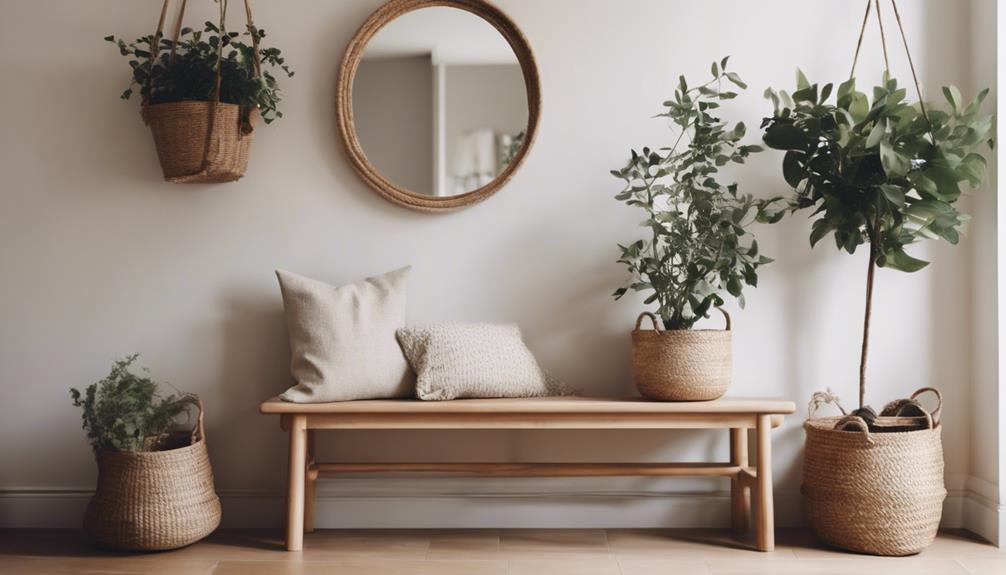
To create a truly inviting Scandinavian entryway, you'll want to focus on decorative elements that elevate the space.
Consider incorporating a handwoven wall tapestry for texture, a ceramic plant pot for a touch of greenery, and geometric wall art to add a modern flair.
These pieces not only enhance the aesthetic but also reflect your personal style while maintaining that clutter-free vibe.
Handwoven Wall Tapestry
Handwoven wall tapestries not only enhance the aesthetic of your Scandinavian entryway but also add warmth and texture, creating a welcoming atmosphere. These beautiful textiles often feature neutral color palettes and simple designs that align perfectly with Scandinavian design principles, emphasizing minimalism and the use of natural materials.
By incorporating a handwoven wall tapestry, you can create a focal point that draws the eye while maintaining a serene and organized entryway. This balance is essential in achieving the clutter-free vibe typical of Scandinavian homes. Additionally, these tapestries serve a functional purpose; they help absorb sound, fostering a peaceful environment that enhances your daily comings and goings.
When choosing a tapestry, look for options made from sustainable materials to support eco-friendly practices. This not only reflects your commitment to nature but also resonates with the Scandinavian ethos of sustainability in home decor.
Incorporating a handwoven wall tapestry can elevate your entryway's style while promoting a sense of tranquility and simplicity, making it a perfect decorative element for your Scandinavian-inspired home.
Ceramic Plant Pot
Incorporating ceramic plant pots into your Scandinavian entryway not only enhances the natural beauty of the space but also aligns with the minimalist aesthetic that defines this design style.
The smooth textures and neutral tones of ceramic pots effortlessly blend into your Scandinavian home, creating a calming atmosphere. Available in various sizes and shapes, they can accommodate a range of indoor plants, which improve air quality and add a revitalizing touch of greenery.
To maintain a clutter-free look, choose ceramic pots with simple, clean designs. Grouping them together or placing them strategically on benches or shelves can maximize space efficiency while adding decorative appeal.
Opt for matte or glossy finishes that complement the Scandinavian emphasis on natural materials, making your entryway warm and inviting.
Geometric Wall Art
Geometric wall art brings a touch of modern elegance to your Scandinavian entryway, enhancing the minimalist aesthetic while adding visual interest. This style emphasizes clean lines and simplicity, perfectly aligning with the uncluttered look you aim for. By opting for pieces in a neutral color palette, like black, white, or soft pastels, you maintain a serene atmosphere that doesn't overwhelm the space.
Incorporating geometric patterns can create a sense of rhythm and harmony, enhancing the spacious feel characteristic of Scandinavian interiors. If your entryway is small, consider oversized geometric wall art as a focal point. This draws attention upward, making the area appear larger and more inviting.
For a more personalized touch, display your geometric wall art in a gallery-style arrangement. This can add style while still adhering to the Scandinavian principles of simplicity and functionality.
Flooring
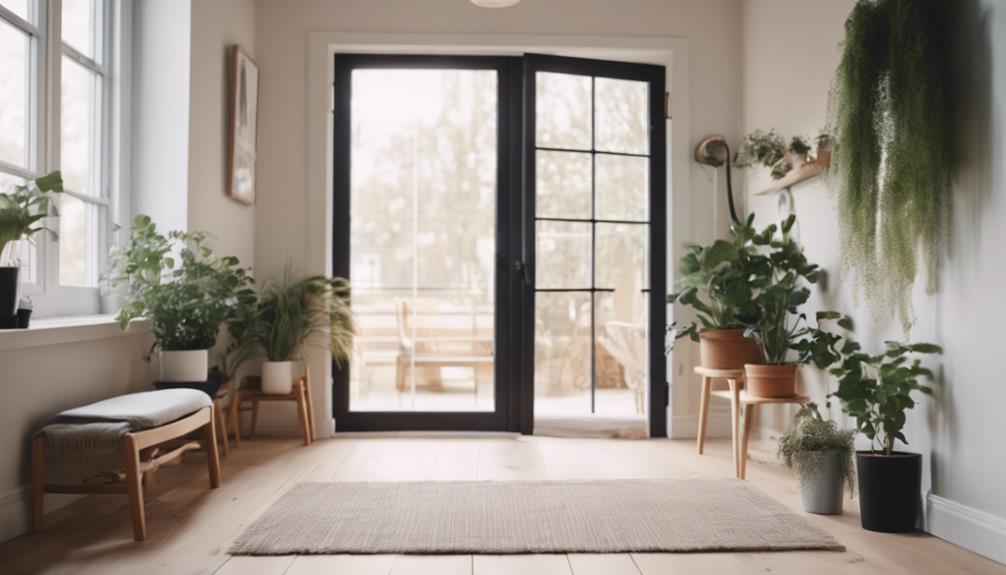
When choosing flooring for your Scandinavian entryway, consider options like warm beige cork, light ash engineered hardwood, or soft grey bamboo.
Each of these materials not only enhances the natural light but also offers durability and style.
You'll create a welcoming and functional space that aligns perfectly with the Scandinavian aesthetic.
Warm Beige Cork Flooring
Warm beige cork flooring adds a touch of warmth and comfort to your Scandinavian entryway while providing excellent durability and natural insulation. This eco-friendly choice not only enhances the aesthetic appeal but also guarantees that your space remains cozy during those chilly months.
Cork flooring is highly resilient, making it perfect for high-traffic areas where heavy footfall is common. You won't have to worry about significant wear, guaranteeing your entryway stays looking fresh and inviting.
The natural texture and softness of cork help reduce noise levels, contributing to a serene atmosphere that complements your clutter-free design. Plus, cork is naturally resistant to mold, mildew, and pests, keeping your entryway clean and hygienic—essential for maintaining that organized feel.
By choosing warm beige cork flooring, you're investing in a sustainable material that's harvested from the bark of cork oak trees without harming them, aligning with eco-conscious values.
Incorporating cork flooring into your entryway not only elevates the style but also supports a healthy living environment. So, if you want a cozy, durable, and stylish entryway, warm beige cork flooring is the way to go.
Light Ash Engineered Hardwood
Light ash engineered hardwood flooring offers a perfect blend of durability and aesthetic appeal, making it an ideal choice for your Scandinavian entryway. This flooring type is particularly well-suited for high-traffic areas, thanks to its resistance to warping and wear. With a thin veneer of real ash over layers of plywood, you get the look of solid wood without compromising on stability or cost.
The naturally pale color of light ash enhances the brightness of your space, beautifully complementing the minimalist Scandinavian design aesthetic. Its subtle grain patterns contribute to a serene, clutter-free environment that invites guests in.
Plus, engineered hardwood is easier to install and maintain compared to solid hardwood, allowing you to focus more on creating a streamlined entryway rather than worrying about upkeep.
Additionally, light ash engineered hardwood often features low-VOC finishes, promoting better indoor air quality and aligning with eco-friendly design principles. By choosing this flooring, you're not just investing in style and durability; you're also making a conscious choice for a healthier home.
This makes light ash engineered hardwood the perfect foundation for your clutter-free Scandinavian entryway.
Soft Grey Bamboo Flooring
Soft grey bamboo flooring brings a sustainable and modern touch to your Scandinavian entryway, seamlessly combining eco-friendliness with stylish design. This flooring choice aligns perfectly with Scandinavian design principles, enhancing that light and airy feel you're aiming for. The neutral tone of soft grey bamboo pairs beautifully with various color palettes, allowing you to create a cohesive and clutter-free look.
One of the standout features of soft grey bamboo flooring is its impressive durability. It's resistant to scratches and dents, making it ideal for high-traffic entryways where shoes and outdoor gear frequently come into contact with the floor. You won't have to worry about wear and tear, which keeps your entryway looking fresh and inviting.
Additionally, soft grey bamboo flooring reflects natural light, contributing to a brighter atmosphere in your space. This not only elevates the aesthetic but also enhances the welcoming vibe of your home. By choosing soft grey bamboo, you're investing in a flooring option that's both stylish and sustainable, perfectly suited for a modern Scandinavian entryway.
Conclusion
By incorporating these proven techniques, you can effortlessly create a clutter-free Scandinavian entryway that welcomes you home.
Focus on key elements, select essential fixtures and furniture wisely, and choose lighting that enhances the space.
Don't forget to add decorative touches that reflect your style while keeping things minimal.
Finally, opt for flooring that complements the overall aesthetic.
With these tips, your entryway will be both functional and beautifully serene, setting the perfect tone for your home.
Home Decor
Light Vs. Dark Wood: Which Is Better for Your Scandinavian Living Room?
Navigate the choice between light and dark wood for your Scandinavian living room and discover which option will truly elevate your space.
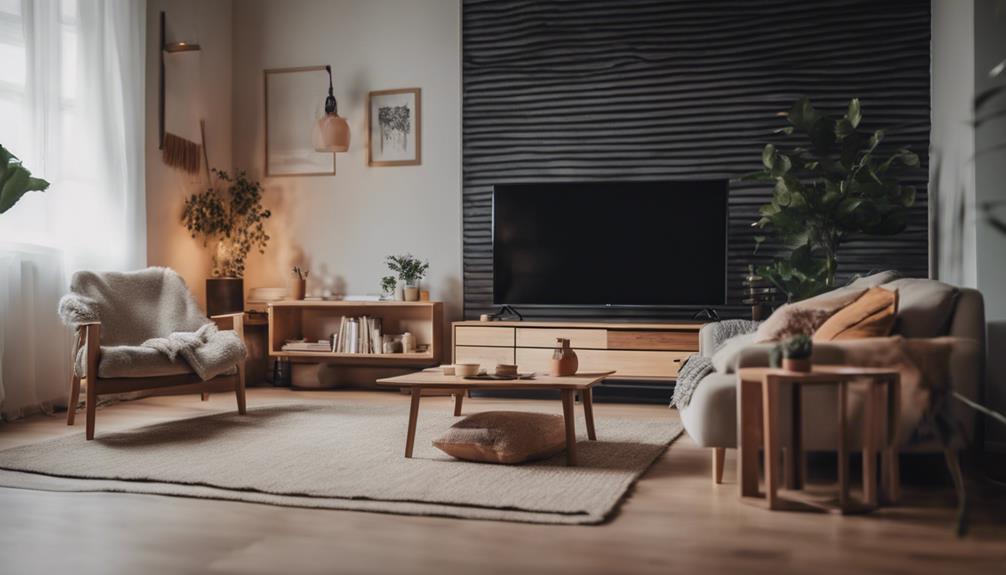
When deciding between light and dark wood for your Scandinavian living room, consider the atmosphere you want to create. Light wood brightens the space, enhancing airiness and maximizing natural light, while dark wood adds warmth and depth, creating a cozy feel. Light floors work well with neutral palettes and reflect light effectively, while dark wood can provide beautiful contrast against light walls. Both options can harmonize with textures and decorative elements. Ultimately, your choice should reflect your personal style and desired ambiance. There's plenty more to explore about how these choices can shape your space.
Key Elements
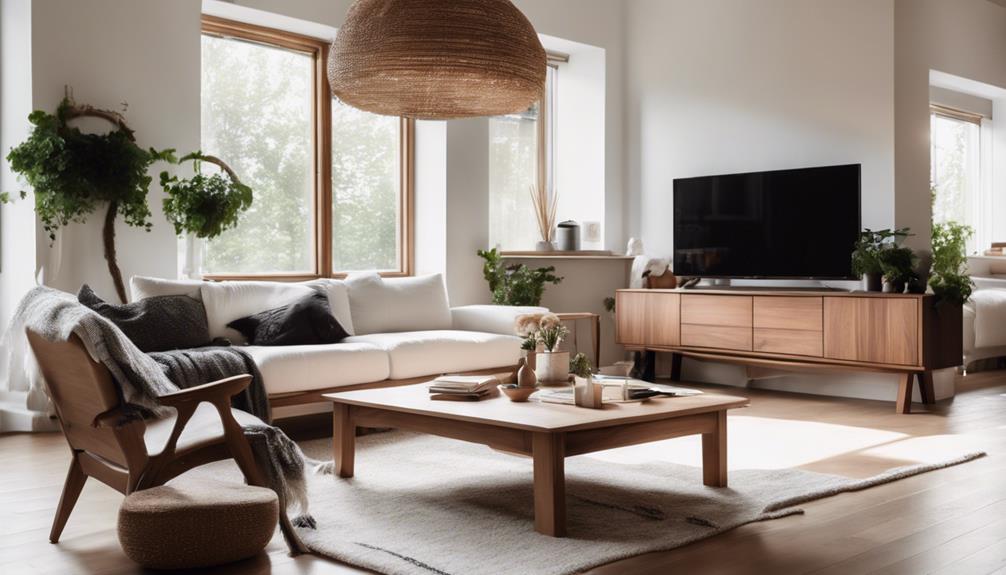
When choosing wood for your Scandinavian living room, consider the key elements of color scheme, materials, and textures.
Light wood can brighten your space, while dark wood brings a cozy feel that adds depth.
Each option influences not just the aesthetics but also the overall vibe of your room.
Color Scheme
In Scandinavian design, the color scheme plays an essential role in harmonizing light wood floors with a neutral palette, enhancing the overall airy and minimalist aesthetic.
When you choose light-colored flooring, like ash or maple, it creates an inviting atmosphere that reflects natural light, making your living room feel more spacious. This choice works beautifully with a neutral color palette, allowing for versatile decor that emphasizes simplicity and functionality.
On the other hand, if you opt for dark wood floors, such as walnut or dark-stained oak, you add a striking contrast that infuses warmth and sophistication into your space. Dark flooring can ground the room, especially when paired with light-colored furnishings, creating a balanced visual appeal.
Consider how the room's lighting conditions affect your choice. Light flooring brightens up dim spaces, while dark wood floors lend depth to well-lit areas.
Remember, incorporating dark wood accents in furniture or decor can enhance your light wood floors, adding visual interest while staying true to the Scandinavian ethos of connecting with nature.
Ultimately, your choice between light and dark wood should reflect your personal style and the atmosphere you want to create.
Materials
Choosing the right materials for your Scandinavian living room can considerably impact the overall aesthetic, whether you prefer the lightness of ash and maple or the richness of walnut and dark-stained oak.
Light wood options, like ash and maple, are popular for their ability to enhance natural light, creating an airy feel that's essential in Scandinavian design. If you opt for light floors, they can make smaller spaces feel more open and inviting, which aligns perfectly with the minimalist ethos.
On the other hand, dark hardwood flooring, such as walnut or dark-stained oak, adds warmth and sophistication. This can create a striking contrast with the light-colored walls and furnishings typical of Scandinavian interiors. Using dark wood accents in furniture or decor can introduce depth, making your living space feel cozy and inviting.
Both light and dark wood flooring materials offer sustainable options, resonating with the Scandinavian values of harmony with nature and environmental consciousness.
Ultimately, your choice of materials will shape the atmosphere of your living room, so consider what best reflects your personal style while staying true to Scandinavian principles.
Textures
Textures are essential in Scandinavian design, blending soft fabrics and natural materials to create a cozy yet modern atmosphere.
When you choose light wood floors, their smooth and airy finish enhances the spacious feel of your living room. This pairs beautifully with textiles like wool and linen, which are staples in Scandinavian decor. You'll notice how these soft materials invite warmth and comfort.
On the other hand, dark wood floors add a rich depth to your space. They provide a striking contrast against light-colored furnishings and textiles, making your living area feel more inviting. The combination of dark wood with varied textures, such as knitted throws and woven baskets, can create a stunning visual balance.
Regardless of whether you opt for light or dark wood floors, incorporating different textures through accessories is crucial. Consider adding rattan or ceramic decor elements to elevate the tactile experience in your Scandinavian living room.
Essential Fixtures and Furniture
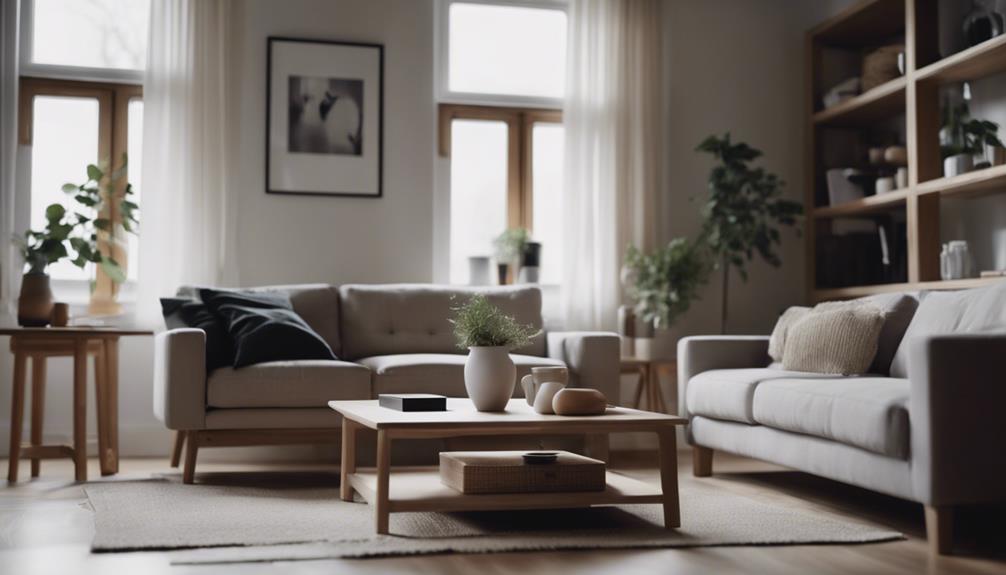
When it comes to essential fixtures and furniture for your Scandinavian living room, choosing the right pieces is key.
You'll want to focus on a Scandinavian-style wooden coffee table, a sleek floor lamp, and a functional bookshelf that all complement your light wood floors.
These items not only enhance the aesthetic but also align with the principles of simplicity and practicality that define Scandinavian design.
Scandinavian-Style Wooden Coffee Table
Scandinavian-style wooden coffee tables bring a perfect blend of functionality and minimalist elegance to your living room. These tables often showcase clean lines and simple designs, embodying the key principles of Scandinavian aesthetics.
Commonly crafted from light woods like ash, birch, and maple, they enhance the airy feel that characterizes Scandinavian interiors. Natural finishes allow the beauty of the wood grain to shine through, adding a timeless touch that complements your decor.
The use of light-colored wood contributes to the bright, neutral palette typical of this style, fostering warmth and comfort in your space.
Many Scandinavian coffee tables also feature integrated storage solutions, such as drawers or shelves, helping you keep your living area tidy and organized. This practical approach not only maximizes space but also maintains the minimalist vibe you're aiming for.
Scandinavian-Style Floor Lamp
Floor lamps often play an essential role in Scandinavian living rooms, providing both stylish illumination and a touch of warmth to the space. When you choose Scandinavian-style floor lamps, you're embracing clean lines and minimalist designs that reflect the simplicity and functionality typical of this aesthetic. These lamps often feature light-colored wood bases, harmonizing beautifully with light wood flooring to create a cohesive and airy atmosphere.
Many designs include adjustable features, such as pivoting heads or extendable arms, giving you versatile lighting options for various activities and moods. The soft, diffused lighting commonly found in these lamps promotes a warm, inviting ambiance, enhancing the cozy feel of your living area.
You'll also find that popular materials for these lamps include metal and fabric shades in neutral tones. Such choices complement both light and dark wood floors while maintaining a serene, balanced look.
Scandinavian-Style Wooden Bookshelf
Incorporating a Scandinavian-style wooden bookshelf enhances the functionality and aesthetic appeal of your living room while maintaining the clean lines and minimalism characteristic of this design.
These bookshelves often feature light wood materials like ash or maple, which promote an airy and open feel in your space.
One of the key benefits of a Scandinavian-style bookshelf is its modular nature. This versatility allows you to arrange the shelving units according to your preferences, making it easy to showcase decorative items alongside your favorite books.
The natural finishes, typically left untreated or lightly oiled, highlight the wood's grain and add a rustic charm that aligns perfectly with the simplicity and nature-focused ethos of Scandinavian decor.
If you want to elevate the ambiance even further, consider a bookshelf with integrated lighting. This addition can beautifully illuminate your displays, creating a cozy atmosphere that complements your overall design aesthetic.
With a Scandinavian-style wooden bookshelf, you're not just adding storage; you're infusing your living room with a sense of style that celebrates both light wood and functional design.
Lighting Ideas
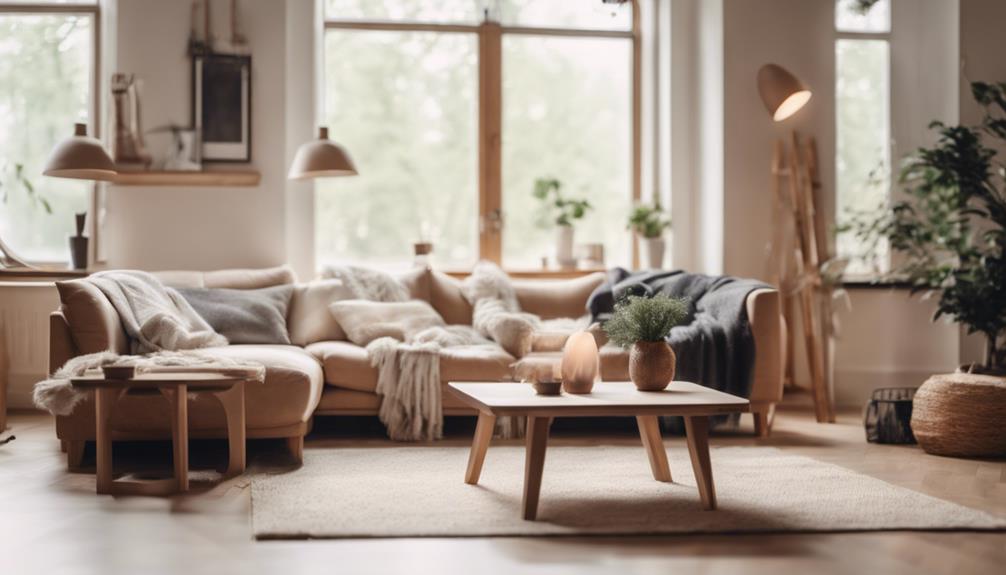
When it comes to lighting your Scandinavian living room, you'll want to focus on creating a warm and inviting atmosphere.
Pendant lights with a soft glow, wall-mounted sconces with dimmers, and recessed ceiling lights can work wonders in enhancing the space.
Don't forget to maximize natural light for an airy feel that beautifully complements both light and dark wood elements.
Pendant Lights With Warm Glow
Pendant lights with a warm glow instantly transform your Scandinavian living room into a cozy retreat, enhancing its minimalist charm. These lights create an inviting atmosphere, perfectly complementing your light wood floors while maintaining the design's clean lines.
When selecting pendant lights, consider options with adjustable brightness. This flexibility lets you set the mood for various occasions, whether you need bright light for tasks or a softer glow for relaxation. Materials like wood, metal, or glass can further amplify the warmth in your space, ensuring a cohesive aesthetic.
Additionally, choosing integrated LED bulbs makes your lighting energy-efficient while still providing that sought-after warm glow. This aligns beautifully with the Scandinavian emphasis on sustainability and natural elements.
To add dimension and visual interest, hang your pendant lights at varying heights. This technique creates a dynamic atmosphere, making your living room feel more engaging.
Wall-Mounted Sconces With Dimmers
Wall-mounted sconces with dimmers let you effortlessly adjust the lighting in your Scandinavian living room, creating the ideal ambiance for any occasion. Whether you're winding down with a book or hosting friends, these sconces provide the perfect solution. You can install them at various heights to enhance the room's aesthetic while delivering focused or ambient light, perfectly aligning with Scandinavian design principles of simplicity and functionality.
Choosing sconces with warm LED bulbs complements your light wood flooring, enhancing that airy, inviting feel typical of Scandinavian interiors. The dimming capability not only allows for mood adjustments but also helps save energy and prolongs the lifespan of your bulbs, making your home more sustainable and eco-friendly.
Modern wall-mounted sconces often feature stylish designs that reflect Scandinavian minimalism, ensuring they blend seamlessly with your decor. This combination of form and function makes them a versatile choice for your living room. So, when you're planning your lighting, consider incorporating dimmable sconces—your space will thank you for the thoughtful touch!
Recessed Ceiling Lights
Recessed ceiling lights bring a sleek and modern touch to your Scandinavian living room, perfectly complementing the minimalist aesthetic. These lights, also known as can lights or pot lights, provide a clean look that aligns seamlessly with the simplicity of Scandinavian design. You can strategically place recessed ceiling lights to highlight specific areas, like artwork or architectural features, enhancing the overall ambiance of your space.
With dimming capabilities, recessed lights allow you to adjust brightness, creating a cozy atmosphere ideal for various activities, from relaxing with a book to entertaining guests. Opting for LED recessed lights also adds an energy-efficient element, reducing electricity consumption while offering ample illumination—especially important for open-concept living areas.
Consider installing recessed lighting in a staggered pattern to add depth to your ceiling, making the room feel larger and more inviting. This design choice complements light wood flooring, commonly found in Scandinavian interiors, enhancing the warm and airy feel of your living room.
Natural Light Maximization Techniques
To create a bright and inviting Scandinavian living room, you should focus on maximizing natural light through large windows and glass doors that seamlessly connect your indoor space with the outdoors. This design choice is central to the Scandinavian aesthetic, which values airy, open areas.
Consider using light-colored curtains or sheer fabrics. They allow sunlight to filter through while maintaining your privacy, enhancing the overall brightness of the room. Additionally, strategically placing mirrors across from windows reflects that precious natural light, creating an illusion of a more spacious and luminous environment.
Opt for light wood flooring, such as ash or maple, to enhance the reflection of natural light. This not only contributes to the minimalist aesthetic but also complements the overall brightness of your living space.
Incorporate light-toned furniture and decor to harmonize with the flooring and walls, ensuring that everything works together cohesively.
Decorative Elements
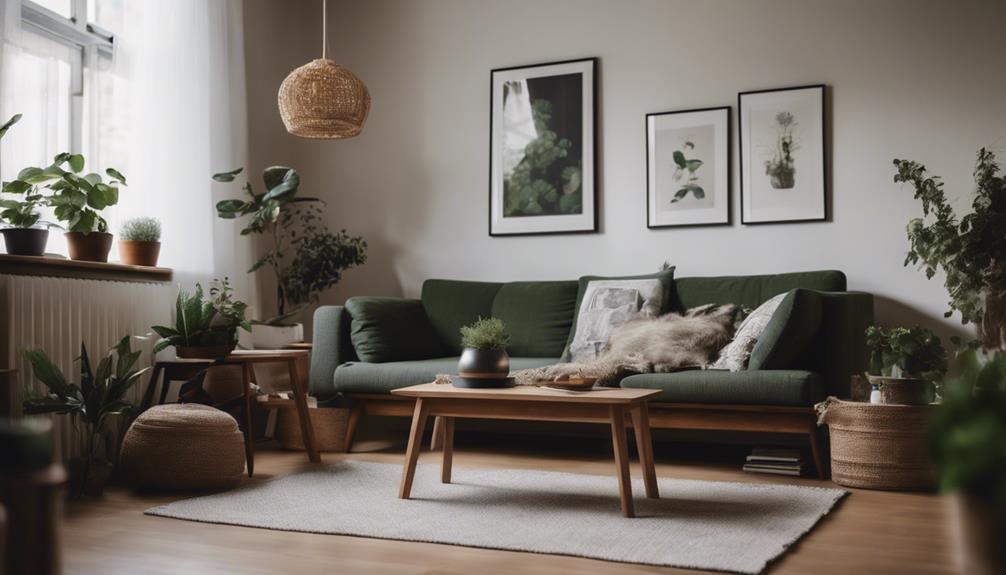
When you're choosing decorative elements for your Scandinavian living room, think about a handwoven wool area rug to add warmth and texture.
A ceramic vase filled with greenery can bring life to your space, while framed botanical wall art adds a touch of nature and sophistication.
Together, these pieces can beautifully complement either light or dark wood, enhancing the overall aesthetic.
Handwoven Wool Area Rug
Handwoven wool area rugs bring texture and warmth to your Scandinavian living room, perfectly complementing the minimalist aesthetic with their natural fibers and artisanal craftsmanship. These rugs work beautifully on both light and dark floors, enhancing the overall design while adding an inviting touch.
One of the standout features of a handwoven wool area rug is its durability. Wool is naturally resilient, making these rugs ideal for high-traffic areas, whether you're hosting family gatherings or simply enjoying daily activities. Their ability to withstand wear and tear means you can invest in a piece that lasts while maintaining comfort.
Additionally, wool rugs excel in regulating temperature and moisture, contributing to a cozy atmosphere that feels welcoming year-round. Plus, their eco-friendly nature aligns with the sustainable design principles central to Scandinavian interiors, as they're made from renewable resources.
With a variety of colors and patterns available, a handwoven wool area rug can serve as a focal point or a subtle accent, elevating your living space's aesthetic. Incorporating one into your room will enhance its warmth and style, making it a perfect choice for your Scandinavian-inspired home.
Ceramic Vase With Greenery
A ceramic vase filled with greenery instantly brings a rejuvenating touch of nature into your Scandinavian living room, embodying the style's focus on simplicity and organic elements.
The smooth, clean lines of ceramic vases create an airy feel that complements the light, minimalist aesthetics typical of Scandinavian design.
When you incorporate greenery, like succulents or ferns, into these ceramic vases, you're not just adding color; you're enhancing the warmth and coziness of your space.
Light-colored ceramic vases are particularly effective at brightening the room, reflecting natural light and reinforcing the Scandinavian principle of maximizing brightness.
Moreover, a ceramic vase with greenery can serve as a focal point in your decor, drawing the eye and adding depth without overwhelming the minimalist theme.
Whether placed on a coffee table, shelf, or windowsill, it harmonizes beautifully with the light wood elements often found in Scandinavian interiors.
This combination of ceramic and greenery not only elevates your decor but also fosters a serene atmosphere, making your living room a peaceful retreat.
Framed Botanical Wall Art
Framed botanical wall art infuses your Scandinavian living room with a revitalizing sense of nature, enhancing the airy and minimalist aesthetic that defines this design style. By incorporating natural elements, you create a serene environment that aligns perfectly with Scandinavian design principles.
Opting for light-colored frames complements your light wood floors, establishing a cohesive and harmonious look. Choose prints with muted green tones to evoke calmness and a deeper connection to nature, which is essential in Scandinavian interiors. This choice not only beautifies your space but also promotes tranquility.
To maintain the clean and organized appearance typical of Scandinavian design, play with varying sizes of botanical art. This adds visual interest and depth without overwhelming your decor. The botanical motifs in your wall art support the Scandinavian principle of bringing the outdoors in, fostering a fresh and vibrant atmosphere in your living room.
Incorporating framed botanical wall art is an effortless way to enrich your Scandinavian aesthetic, making your space feel inviting and connected to the natural world. Embrace these elements, and transform your living area into a peaceful retreat.
Flooring
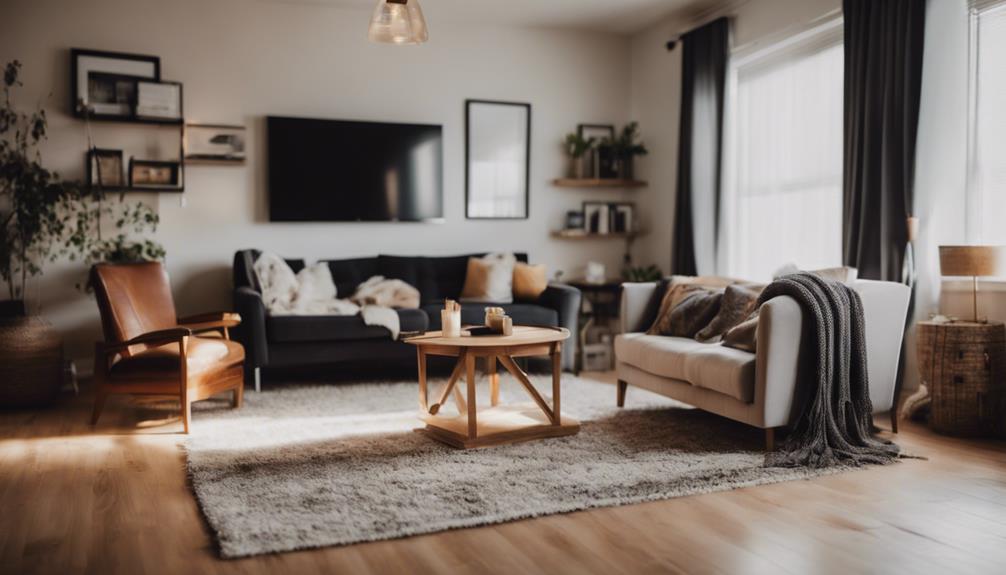
When choosing flooring for your Scandinavian living room, consider light options like ash or whitewashed oak planks.
These materials not only brighten the space but also fit seamlessly into the minimalist aesthetic.
Pale maple wide planks can also enhance the airy feel while providing a fresh, clean look.
Light Ash Plank Flooring
Light ash plank flooring enhances your Scandinavian living room by maximizing natural light and creating an airy, spacious atmosphere. Its pale tones reflect light effectively, making your space feel brighter and more open, especially when paired with light-colored walls. This combination not only amplifies the natural light but also contributes to the minimalist aesthetic that defines Scandinavian design.
One of the great benefits of light ash plank flooring is its practicality. The lighter shades help hide dust and pet hair, so you won't have to worry about constant cleaning in your busy household. Its durability and resistance to wear make it an ideal choice for high-traffic areas, ensuring it stands up to your family's daily activities.
Additionally, the natural grain patterns of light ash add subtle texture and warmth to your living room, creating a cozy environment. This flooring complements neutral color palettes beautifully, tying together the elements of your Scandinavian-inspired decor.
When you choose light ash plank flooring, you're not just selecting a surface; you're enhancing the overall ambiance and functionality of your living space.
Whitewashed Oak Plank Flooring
Whitewashed oak plank flooring transforms your Scandinavian living room by providing a fresh, airy aesthetic that beautifully complements minimalist design elements. This light flooring option reflects natural light, making your space feel larger and brighter—perfect for the often smaller rooms typical in Scandinavian homes.
Opting for whitewashed oak not only enhances the overall look but also offers durability and practicality. The whitewashed finish conceals minor scratches and dirt, making it a practical choice for high-traffic areas while maintaining a clean and fresh appearance. You'll appreciate how it pairs seamlessly with both light and dark furniture, allowing you to create a cohesive design that emphasizes contrast and balance in your decor.
Investing in whitewashed oak means you're choosing a timeless style that endures, thanks to its robust nature and protective finish. It's a sound investment for homeowners who want both beauty and functionality.
With whitewashed oak, you'll enjoy a Scandinavian living room that feels inviting and stylish, all while ensuring your flooring stands up to everyday life. Embrace the light and airy vibe with this stunning flooring choice!
Pale Maple Wide Plank Flooring
Pale maple wide plank flooring brings an effortless elegance to your Scandinavian living room, enhancing the airy atmosphere that defines minimalist design. The light hue of pale maple reflects natural light, creating the illusion of a more spacious environment. This feature is particularly beneficial in smaller rooms, making your space feel open and inviting.
Durability is another significant advantage of pale maple. Known for its resistance to wear and tear, this flooring choice stands up well in high-traffic areas while maintaining its beauty. Its subtle grain pattern adds visual interest without overwhelming your decor, allowing it to harmoniously integrate with neutral-colored furnishings.
Moreover, maintaining pale maple wide plank flooring is a breeze. The lighter color effectively conceals dust and pet hair, making it ideal for busy households. By choosing pale maple, you're not only selecting a stylish option but also a practical one that supports your Scandinavian living room's overall aesthetic.
With pale maple as your choice for light hardwood floors, you'll enjoy a combination of elegance, durability, and ease of maintenance in your home.
Conclusion
Ultimately, choosing between light and dark wood for your Scandinavian living room comes down to your personal style and the vibe you want to create.
Light wood can brighten the space and give it a fresh, airy feel, while dark wood adds warmth and depth.
Consider your existing fixtures, lighting, and decorative elements to make the best choice.
Whichever you pick, both options can beautifully complement the Scandinavian aesthetic, making your living room a cozy retreat.
Home Decor
Creative DIY Projects to Transform Your Home This August – You’ll Love the Results!
Get inspired this August with creative DIY projects that will transform your home—discover the joy of crafting unique decor you'll love!
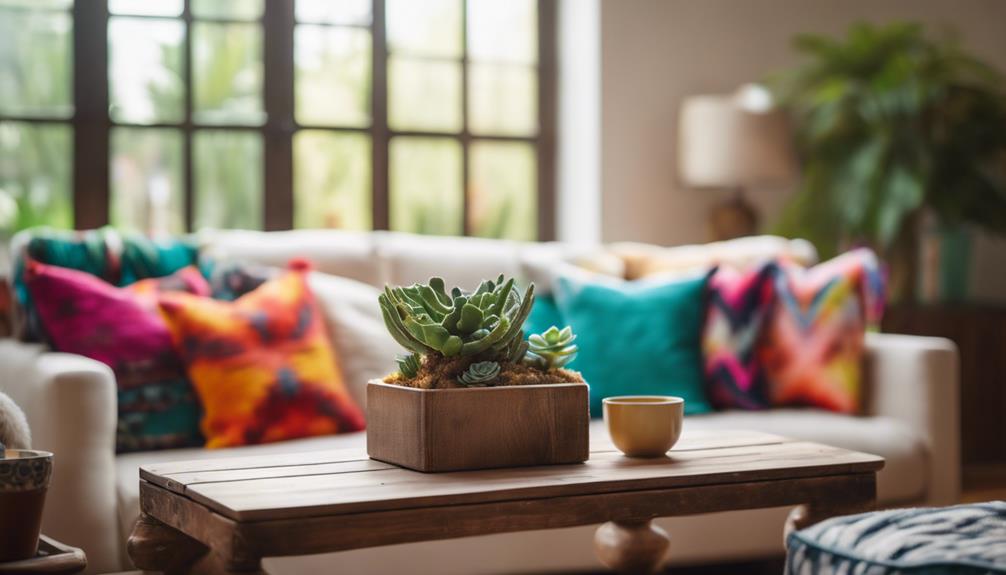
This August, you can transform your home with creative DIY projects that are both fun and functional. Try making a cozy tassel throw blanket or a unique coffee bar sign to add personal charm. Upcycle old items, like transforming a vintage globe into decor, or refresh your furniture with a stunning coffee table makeover. You'll love the rustic appeal of a farmhouse-style coat rack or a decorative wall art piece using scrapbook paper. These projects are easy and budget-friendly, allowing you to express your style while enhancing your space. Imagine the joy of the results you'll achieve as you explore more ideas!
Key Takeaways
- Create personalized wall decor like a DIY Coffee Bar Sign or Vintage Map Decoupage Letter to add character to your spaces.
- Enhance functionality with DIY projects like a Hanging Shelf or Farmhouse Style Coat Rack for stylish and practical storage solutions.
- Transform textiles into cozy accents by crafting an Easy DIY Tassel Throw Blanket, perfect for adding warmth to any room.
- Upcycle furniture creatively, such as revamping a coffee table or transforming an old file cabinet into stylish office storage.
DIY Signs and Wall Decor
DIY signs and wall decor can instantly elevate your home's aesthetic, allowing you to express your personality and style with just a few simple projects. One great idea is creating a DIY Coffee Bar Sign. This farmhouse-style project adds charm to your kitchen and can be customized in colors and sizes to fit your space perfectly. It's an ideal starting point for beginners enthusiastic to enhance their decor.
Another fun project is the Vintage Map Decoupage Letter. Using old maps and Mod Podge, you can quickly personalize your decor, making it a unique gift or an accent that adds character to any room.
If you're looking for something a bit more creative, try making Glue Art on Canvas. This engaging project allows you to use hot glue or regular glue with acrylic paint, making it suitable for everyone, including kids.
Lastly, consider Scrapbook Paper Wall Art. This quick project only requires minimal materials and effort, and you can easily customize it with different paper designs. It's a fantastic way to brighten up dull wall spaces.
With these ideas, you're set to transform your home with stunning DIY signs and wall decor!
Functional Furniture Enhancements
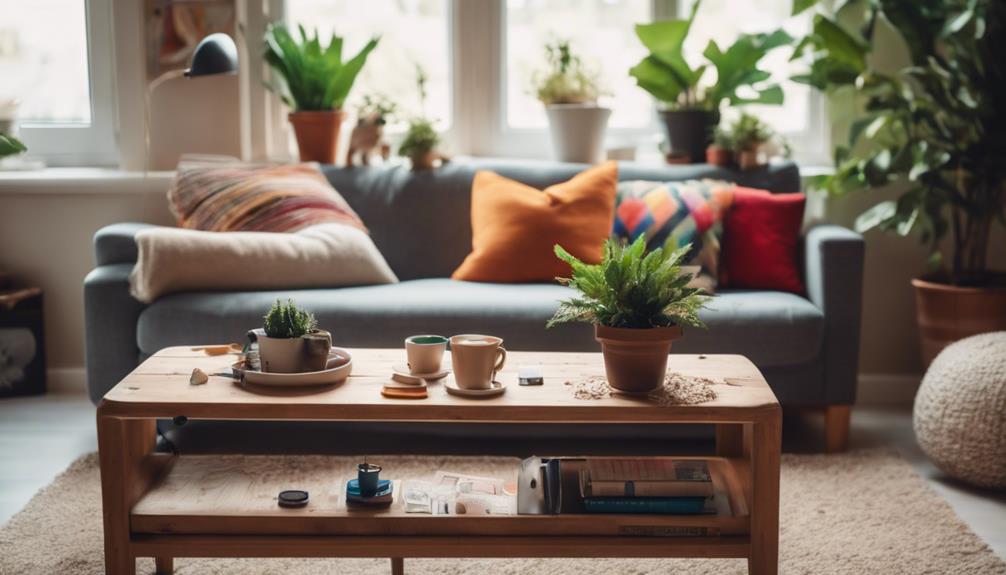
Transforming your home with functional furniture enhancements can elevate both style and practicality, making everyday living more enjoyable. These DIY projects not only add aesthetic appeal but also provide clever storage solutions without overwhelming your space. Here are some ideas to reflect upon:
- DIY Hanging Shelf: Use leather straps to create a stylish shelf that fills empty wall spaces and showcases your favorite items.
- Farmhouse Style Coat Rack: This dual-purpose piece provides storage for coats while enhancing your home's rustic decor.
- DIY Outdoor Bench: With minimal materials, you can create a modern bench perfect for indoor or outdoor use, all without screws or nails.
- Decorate a Wooden Stool: Customize a wooden stool with paper and Mod Podge, giving it both a functional and decorative touch.
These functional furniture enhancements help you maximize space and create a home that's both beautiful and practical.
Immerse yourself in these projects this August and watch your living space transform!
Cozy Textiles and Comfort

Cozy textiles can instantly warm up your living space and create a welcoming atmosphere that invites relaxation. You don't need to be a crafting expert to enhance your home with DIY projects.
Simple creations like an Easy DIY Tassel Throw Blanket can add both color and texture using inexpensive materials like brightly colored yarn. This project not only elevates your decor but also provides warmth on chilly evenings.
Another quick and customizable option is decorating a wooden stool with paper and Mod Podge. This not only improves its aesthetics but also makes it a functional piece in small spaces.
If you're looking for a way to display your cozy textiles, consider creating an Easy Rustic Blanket Ladder. It costs about $10-$15 and takes roughly three hours to complete, giving you a stylish way to showcase your blankets.
These cozy textiles enhance the comfort of your living areas and can be crafted with minimal skills. So, gather your materials and get started!
You'll soon transform your home into a haven of warmth and comfort, perfect for unwinding after a long day.
Creative Upcycling Projects
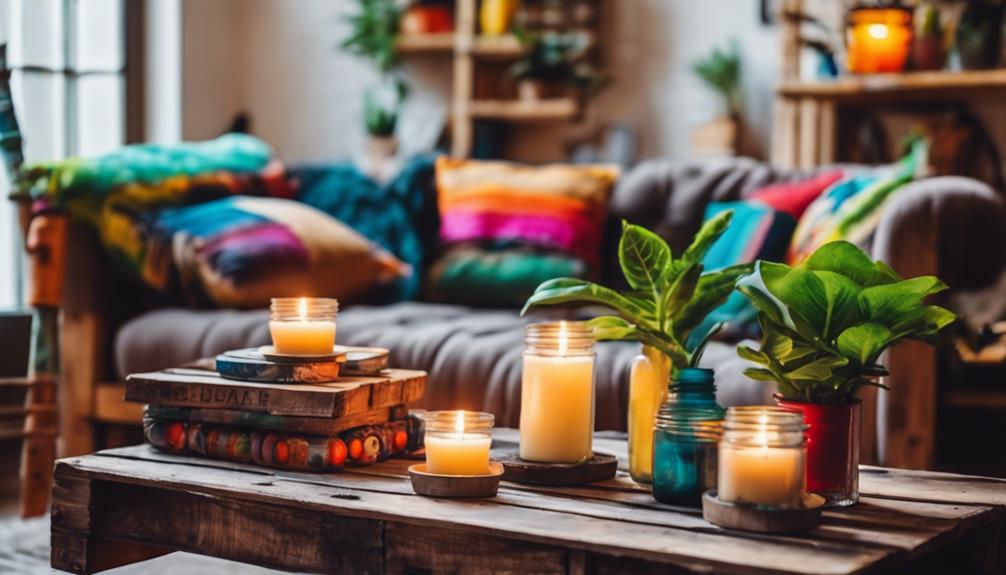
Upcycling old furniture and decor items not only adds unique character to your home but also promotes sustainability by reducing waste. By engaging in creative upcycling projects, you can transform overlooked pieces into functional art that reflects your style.
Here are some ideas to inspire you:
- Give a coffee table a makeover with a fresh coat of paint or new hardware to breathe new life into your living space.
- Transform an old file cabinet by covering it with fabric or paint, turning it into a stylish and functional piece for your office.
- Repurpose wooden crates into charming storage solutions or decorative shelves, adding a rustic touch to your decor.
- Utilize vintage items like a globe, turning it into a unique decor piece that tells a story while showcasing your personality.
These creative upcycling projects not only save you money but also bring a sense of accomplishment that makes your home truly one-of-a-kind.
Personalized Home Accessories
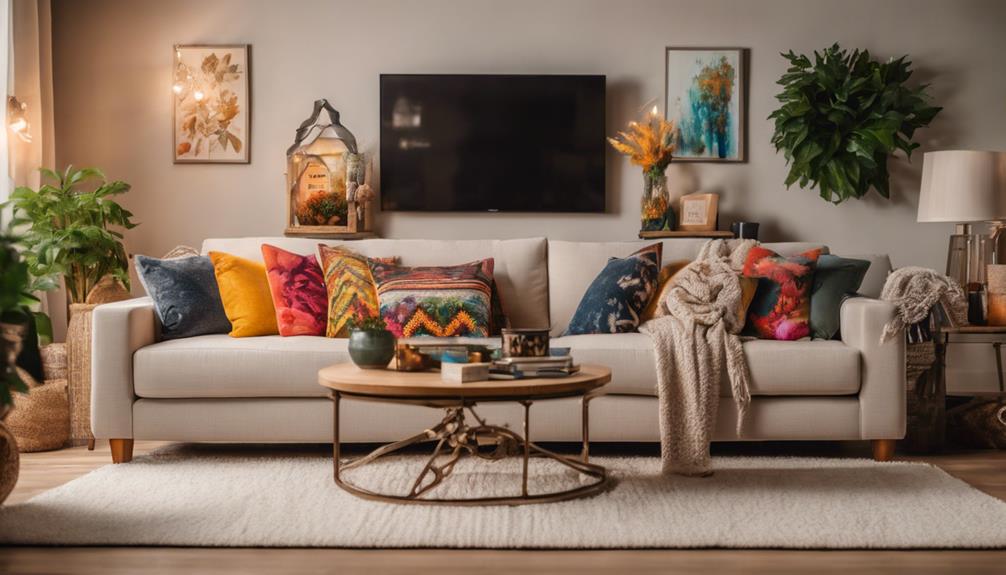
Personalized home accessories add a unique touch to your decor, allowing you to showcase your personality and cherished memories in every room. One fun project is creating photo transfer pillows using Mod Podge Photo Transfer Medium. You can customize these pillows with meaningful images that not only reflect your style but also serve as great conversation starters.
Another creative idea is revamping vintage globes to display your favorite photos. This imaginative decor adds character to any space and truly stands out. You can also try your hand at vintage map decoupage letters, which can be tailored to fit your personal aesthetic—perfect for gifts or unique home accents.
Engaging in these DIY projects not only enhances your decor but also provides a fun and creative crafting experience. You might even involve family and friends, making it a memorable activity.
Personalized home accessories serve as both functional and sentimental pieces, transforming your living space into a reflection of who you are. So, gather your supplies and start crafting—your home will thank you for the personal touch!
Decorative Wall Art Ideas
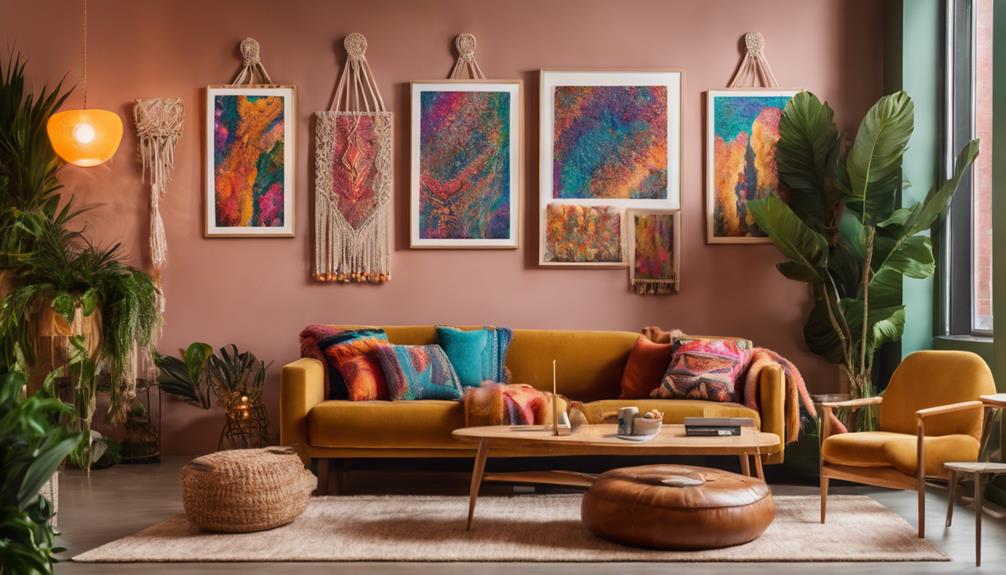
When it comes to adding personality to your walls, budget-friendly mosaic art and scrapbook paper wall decor are great options you can tackle.
You can easily create vibrant designs or customize paper to suit your style.
Let's explore how these projects can transform your space without breaking the bank.
Budget-Friendly Mosaic Art
Transform your wall spaces with budget-friendly mosaic art that sparks creativity and adds a vibrant touch to your home.
This DIY project is perfect for beginners, as it requires no grout and can be made using easily accessible materials. You can express your artistic side while brightening up dull areas with unique designs.
Here are some materials you can use for your mosaic art:
- Broken tiles
- Glass pieces
- Colorful paper scraps
- Old CDs or DVDs
Mosaic art isn't just visually appealing; it's also customizable. You can choose colors and patterns that complement your decor and reflect your personal style.
Plus, this project encourages recycling and upcycling, allowing you to make use of leftover materials from previous crafts or home renovations.
Creating mosaic art can be a therapeutic activity, whether you're working alone or hosting a crafting session with friends.
Scrapbook Paper Wall Decor
Create vibrant scrapbook paper wall decor that instantly brightens up your space while showcasing your unique style. This quick and easy DIY project uses colorful scrapbook paper and wood pieces, making it a budget-friendly option for enhancing your home decor. You'll love how simple it is to customize your designs, allowing you to reflect your personality and complement your existing decor.
Gather minimal materials, making this project accessible for crafters of all skill levels, including beginners enthusiastic to experiment with wall art. Start by selecting your favorite scrapbook paper patterns, then cut them into shapes or frames. Attach them to wood pieces or directly to your wall for a striking visual impact.
Once finished, your scrapbook paper wall decor is perfect for display on mantels or walls, adding a pop of color to any room. Plus, this versatile project can be tailored to suit seasonal themes or special occasions, ensuring your decor evolves with the times.
Immerse yourself in this creative endeavor and watch your space transform into a vibrant reflection of you!
Seasonal Decor Inspirations
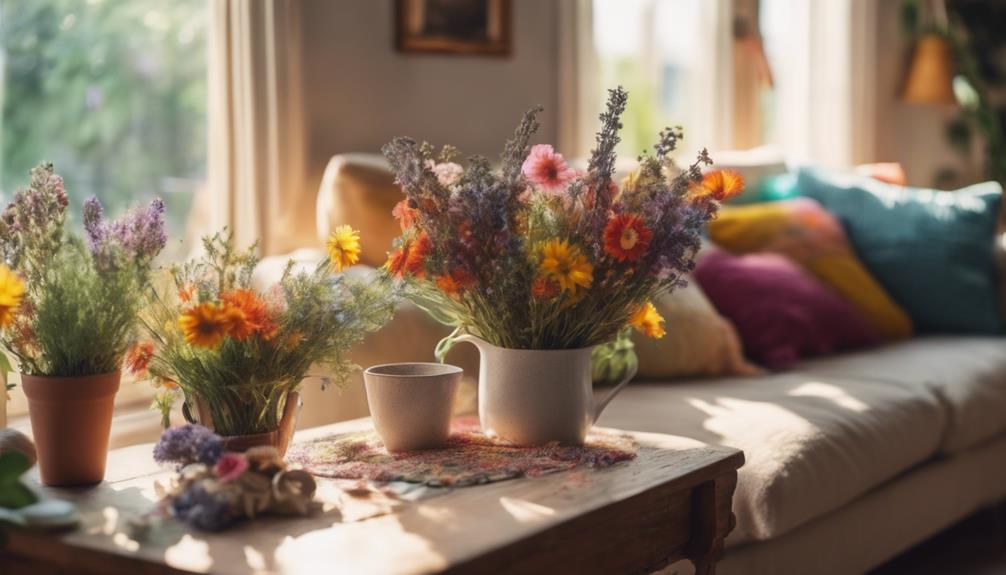
Embracing seasonal decor can instantly breathe new life into your home, making it feel fresh and inviting for gatherings and celebrations. This August, let's explore some vibrant seasonal decor inspirations that'll enhance your space and create a cozy atmosphere.
- Burlap Wreaths: Create easy burlap wreaths to hang on your front door, welcoming guests with rustic charm.
- DIY Lace Mason Jars: Transform ordinary mason jars with lace for a delicate touch, perfect for displaying summer flowers.
- Tassel Throw Blankets: Craft a homemade tassel throw blanket in bright colors, adding warmth and texture to your living room.
- Giant Paper Flowers: Make eye-catching giant paper flowers to serve as whimsical focal points in any room.
These projects aren't only enjoyable but also quick to complete, ensuring your home reflects the joyful spirit of summer. So gather your supplies and start crafting; you'll love the results!
Budget-Friendly Decor Solutions

Finding budget-friendly decor solutions can refresh your home without straining your wallet, allowing for creativity and personalization.
One great project is DIY decorative books. Simply cover book spines with fabric and Mod Podge for a stylish touch that enhances your bookshelves. You'll love how this cost-effective solution adds a handmade flair to your space.
Another fantastic idea is using a budget-friendly poster hanger. With scalloped wood trim and magnets, you can easily display art and photography in a customizable way. This approach keeps your decor fresh without breaking the bank.
If you're looking for quick wall art, consider decorating with scrapbook paper. It's simple and requires minimal materials, making it perfect for matching any room's theme.
For a charming seasonal touch, create lace mason jars in under an hour. These versatile pieces can brighten any space using inexpensive supplies.
Lastly, don't underestimate decorative books on coffee tables or shelves. Customizing their covers with various fabrics offers an easy, budget-friendly way to refresh your home decor.
Embrace these budget-friendly decor solutions, and watch your home transform beautifully!
Large Scale Decor Projects
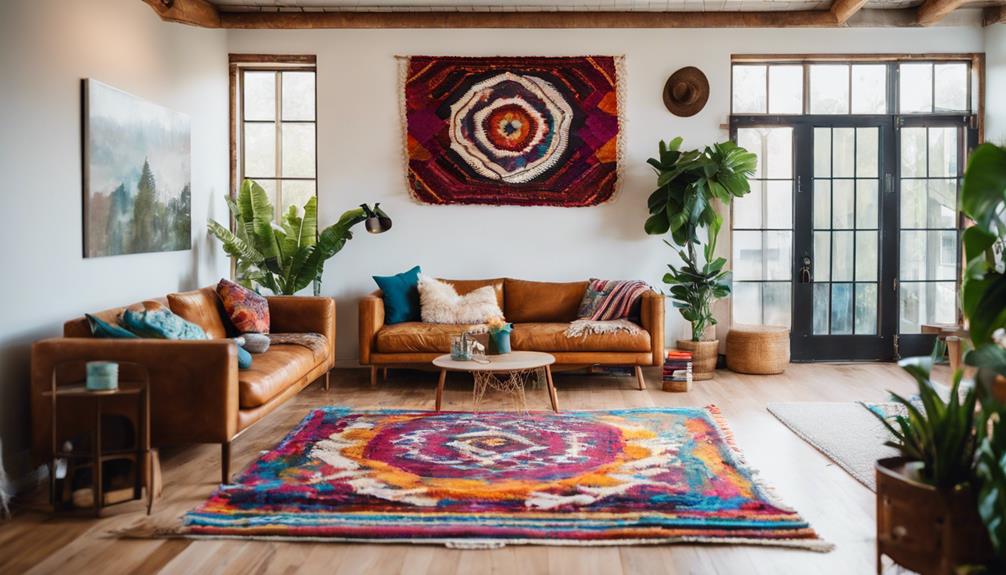
When you're looking to make a big impact in your home, large scale decor projects can transform your space without breaking the bank.
From a budget-friendly chalkboard that sparks creativity to striking wall art ideas, these projects offer both style and function.
Let's explore how you can elevate your decor with some simple yet impactful DIY solutions.
Budget-Friendly Chalkboard Project
Transform your space with a budget-friendly chalkboard that adds both style and functionality to any room. This DIY project not only enhances your decor but also serves as a practical tool for reminders and to-do lists.
You can create your large-scale chalkboard using affordable plywood or MDF boards, which you can easily find at local hardware stores.
Here's what you'll need:
- Plywood or MDF board
- Chalkboard paint
- Sandpaper
- Paintbrush or roller
With materials costing between $30 to $50, this budget-friendly chalkboard project is an economical choice that can be customized to fit your space—be it a kitchen, playroom, or home office.
Even if you're a beginner, detailed step-by-step instructions will guide you through the process, ensuring you achieve fantastic results.
Once completed, your chalkboard won't only look great but will also help you stay organized, allowing you to jot down menus, reminders, or creative ideas.
Immerse yourself in this DIY project, and watch how it transforms your home into a more stylish and functional space!
Creative Wall Space Ideas
Explore creative wall space ideas that not only elevate your decor but also maximize functionality in every room of your home. Large-scale decor projects can transform your walls into focal points while adding practicality. Here are some inspiring ideas for you:
| Project | Purpose | Style |
|---|---|---|
| Huge Chalkboard | Creativity and organization | Fun and functional |
| DIY Wood Striped Wall | Modern focal point | Contemporary elegance |
| DIY Hanging Shelf | Decorative storage | Versatile and stylish |
| Large Mosaic Art | Brighten dull areas | Expressive and unique |
| Photo Gallery Wall | Personalization | Custom and impactful |
Functional Decor Solutions
Functional decor solutions not only enhance the beauty of your home but also serve practical purposes, allowing you to maximize space and usability with large scale projects. By incorporating these solutions, you can create stunning focal points while addressing everyday needs. Here are some ideas to get you started:
- DIY chalkboard wall: This encourages creativity and keeps your family organized, perfect for playrooms or kitchens.
- Wood striped wall: Use wood panels to transform large, undecorated walls into modern statement pieces.
- Multi-functional shelving: Build shelves that combine storage with display, optimizing wall space and keeping your home tidy.
- Bench seating with storage: Construct benches that not only provide seating but also hide away toys or blankets, ideal for entryways or living rooms.
These functional decor solutions not only refresh your home's aesthetic but also improve livability, all while being budget-friendly.
Plus, with just a few basic tools, you can tackle these projects regardless of your skill level. Embrace the challenge and enjoy the transformation!
Whimsical Touches for Fun
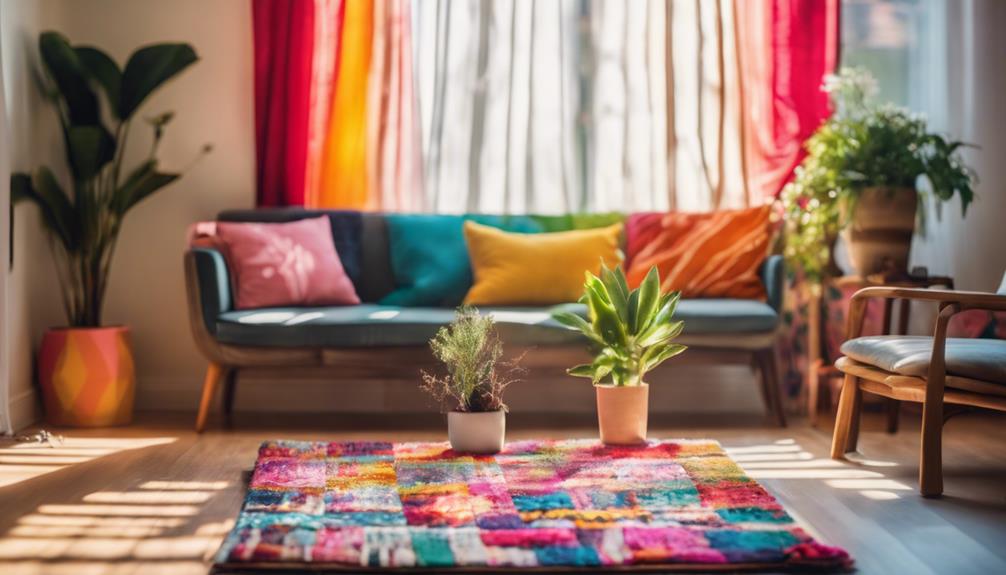
Adding whimsical touches like giant paper flowers can instantly brighten up your home and bring a playful vibe to any room.
These versatile decor options are perfect for spaces like playrooms or nurseries, transforming dull walls into vibrant focal points.
Plus, they're easy and inexpensive to create, making them accessible for DIY enthusiasts of all skill levels. You can craft them using basic materials like cardstock or tissue paper, allowing you to customize size, color, and design to fit your personal style.
Incorporating giant paper flowers into your decor not only adds a fun element but also makes for great conversation starters.
Whether you're decorating for special occasions like birthdays or weddings or simply sprucing up your everyday decor, these whimsical touches can be tailored to suit any event.
Additionally, the crafting process can be a delightful family activity, encouraging creativity and collaboration among loved ones.
You'll end up with unique pieces that reflect your home's personality while creating lasting memories together.
Frequently Asked Questions
What Is the Most Popular DIY Project?
The most popular DIY project often varies, but creating a DIY coffee bar sign stands out. It's simple, customizable, and perfect for beginners, enhancing your kitchen decor while adding a personal touch you'll love.
When Should You Give up on a DIY Project?
You should consider giving up on a DIY project when it overwhelms you, exceeds your budget, or no longer matches your skills. If it causes frustration or you've lost excitement, it might be time to move on.
What Do the Letters DIY Stand For?
DIY stands for "Do It Yourself." It's about creating, modifying, and personalizing projects on your own. You tap into your creativity, save money, and enjoy the satisfaction that comes from completing tasks independently.
What Is the Easiest Project to Make?
The easiest project to make is the Lace Mason Jars. You can create them in under an hour, using simple materials that add charm and versatility to your seasonal decor without much effort or cost.
Conclusion
As August rolls in, don't let your home miss out on the magic of transformation.
Imagine stepping back and seeing your space come alive with vibrant colors, personalized touches, and cozy comforts.
What if you could create a stunning focal point that sparks joy every time you walk by?
Grab your tools, release your creativity, and immerse yourself in these DIY projects.
You won't believe the amazing results waiting for you—are you ready to start your home's exciting journey?
Home Decor
How to Create a Seamless Flow Between Indoor and Outdoor Spaces – Expert Tips!
Perfect your home's harmony by mastering the art of blending indoor and outdoor spaces—discover essential tips that will transform your living experience!
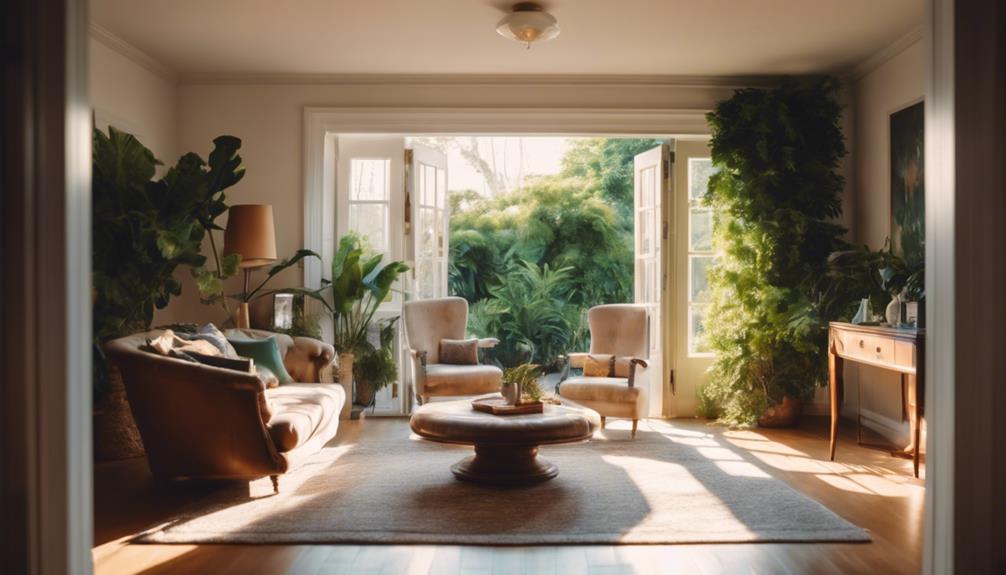
To create a seamless flow between your indoor and outdoor spaces, start by evaluating your layout and identifying any obstacles. Use large glass doors for easy access and to invite natural light in. Choose consistent flooring and a harmonious color palette to unify the areas visually. Clearly define activity zones, ensuring outdoor spaces are easily reachable from indoors. Incorporate greenery and natural elements to enhance the connection. Multi-functional furniture can also optimize your space. These steps will enhance your living experience and mood, making your home a serene retreat. Stick around for more expert tips on crafting that perfect flow!
Key Takeaways
- Assess and eliminate flow obstacles by organizing furniture and optimizing door and window placements for easy movement between spaces.
- Use large glass doors to enhance accessibility and natural light, creating a visual connection between indoor and outdoor areas.
- Choose consistent flooring materials and color palettes to visually unify indoor and outdoor spaces for a cohesive design.
- Define activity zones outdoors with specific furniture arrangements to promote functionality and encourage interaction with indoor areas.
Benefits of Seamless Spaces
Creating seamless indoor-outdoor spaces offers numerous benefits that can greatly enhance your living experience and well-being. By fostering a seamless flow between indoor and outdoor spaces, you'll create a harmonious environment that promotes relaxation and enjoyment. Imagine the joy of stepping from your living room into a beautifully designed patio, where the natural beauty of your garden greets you.
This connection to the outdoors not only improves your mood but also boosts your overall health with fresh air and sunlight. A cohesive design that blends your interior and exterior spaces expands your usable living area, allowing you to entertain guests, enjoy family meals, or simply unwind while surrounded by nature.
Moreover, the appeal of these seamless spaces often translates to increased home value, attracting potential buyers who prioritize outdoor living. When your home offers this kind of integrated experience, it reflects a lifestyle that values both comfort and connection to the environment.
Embrace the benefits of seamless spaces, and watch as your living experience transforms into a tranquil retreat that enhances your quality of life.
Planning the Transition
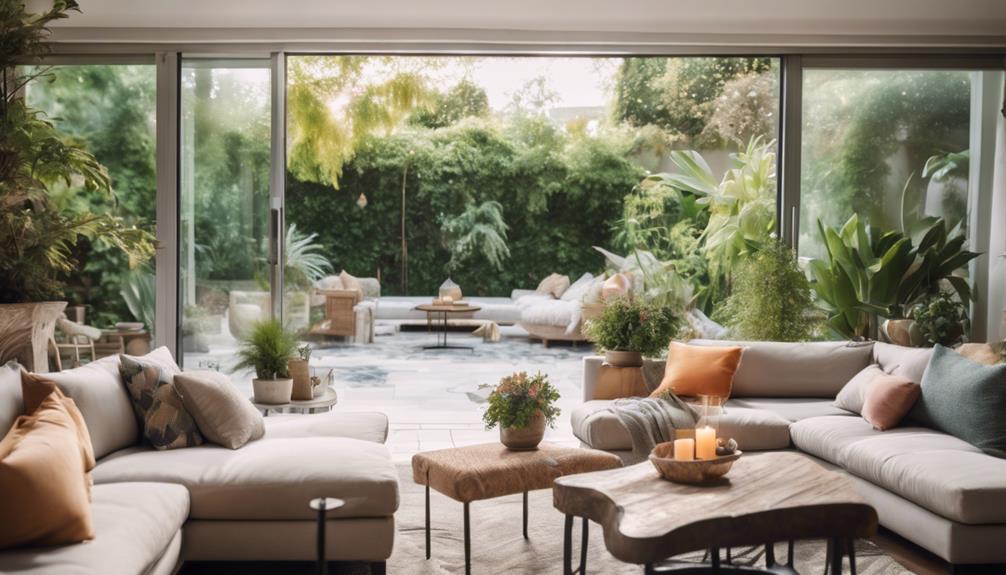
When planning the shift between indoor and outdoor spaces, start by evaluating the layouts to pinpoint key features and any flow obstacles.
You'll want to identify areas that might restrict movement and think about how to enhance those shifts.
This careful evaluation sets the stage for a seamless and inviting connection between your spaces.
Assess Space Layout
Evaluate the layout of your indoor and outdoor spaces to pinpoint obstacles that could disrupt the seamless flow between them. Begin by evaluating how each area functions and how they can complement one another. Consider transitional points like doors and windows, guaranteeing they enhance movement while maintaining a cohesive design.
| Indoor Space | Outdoor Space | Functionality |
|---|---|---|
| Living Room | Patio | Relaxation & Socializing |
| Kitchen | Outdoor Kitchen | Cooking & Dining |
| Dining Area | Garden | Dining & Entertaining |
Choose versatile furniture and accessories that shift smoothly between both environments. This choice will not only enhance usability but also create a unified aesthetic that blurs the boundaries of indoor and outdoor living. Incorporating similar materials and color palettes will further secure a seamless indoor-outdoor living space. By focusing on these elements, you can create inviting areas that feel connected, enhancing the overall flow and functionality of your home.
Identify Flow Obstacles
Identifying flow obstacles between your indoor and outdoor spaces is key to guaranteeing an effortless movement and connection between them. Start by evaluating both areas to pinpoint anything that could disrupt a seamless shift. Look for walls, furniture placement, or uneven ground that might hinder access.
Examine your doorways and windows for size and accessibility. Consider oversized options like sliding or bi-fold doors to create a more open feel.
Next, plan clear pathways by organizing your furniture and decor to avoid clutter. Ascertain that routes between your indoor and outdoor spaces remain unobstructed.
Think about the layout of both areas; placing outdoor dining close to the indoor kitchen can enhance entertaining. Additionally, watch for any changes in floor levels or materials that could disrupt the flow.
Selecting consistent flooring options can visually unify both spaces and make the shift feel natural.
Floor Plan Considerations
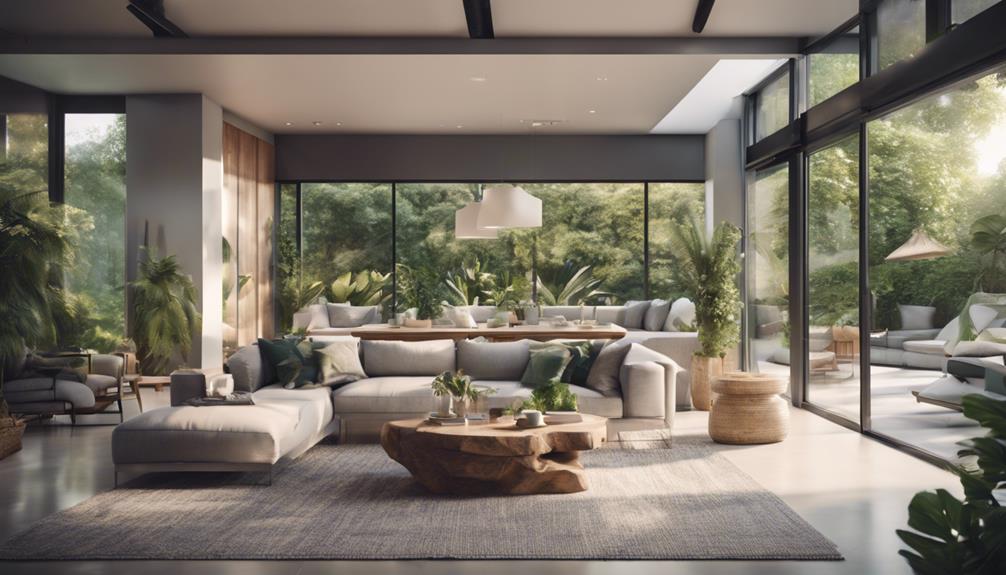
When planning your floor plan, think about where you'll place changeover points like doors and patios to enhance flow.
Evaluating these locations helps you maximize accessibility and visual connections between indoor and outdoor areas.
A functional layout not only supports social gatherings but also guarantees smooth movement throughout your space.
Strategic Transition Locations
To create a seamless flow between indoor and outdoor spaces, focus on key connecting points like patios, decks, and doorways that facilitate smooth movement. Identify these connecting points to guarantee that the layout encourages natural navigation, making it easy to move between indoor and outdoor living.
Utilizing large glass doors is essential; they not only enhance accessibility but also create a visual connection with your outdoor living spaces. Position these doors strategically to promote a cohesive design, allowing sunlight to flood in while providing stunning views of your garden or patio.
When planning your floor layout, consider how the functional areas—like cooking, dining, and entertaining—interact with both environments. Ensure that outdoor living spaces are conveniently connected to indoor areas, making it easy for guests to flow seamlessly during gatherings.
Transitional Points Evaluation
Evaluate your floor plan to pinpoint key interchange points that enhance the flow between indoor and outdoor spaces.
Start by evaluating the layout of both areas to identify strategic transitional points, such as patios or decks. These spots should facilitate seamless movement and connection, promoting indoor-outdoor living.
Next, evaluate the functionality of your transitional points, including doors and windows. Ascertain they enhance accessibility and create an inviting atmosphere. Large openings, like sliding or bi-fold doors, can greatly boost natural light and create a more cohesive design. They blur the lines between the indoors and outdoors, making both areas feel like one.
Be mindful of potential obstacles, such as walls or furniture placement, that might disrupt this flow. Plan for their removal or adjustment to maintain a smooth interchange.
Your goal is to create a space where movement feels effortless, allowing you to enjoy both environments fully. With thoughtful consideration of these factors, you can create a harmonious connection between your indoor and outdoor spaces, enhancing your overall living experience.
Functional Layout Design
Designing a functional layout for indoor-outdoor spaces involves strategically placing patios or decks to enhance accessibility and maximize views from main living areas. Start by evaluating the placement of doors and windows; these connecting points are crucial for creating a seamless connection between your indoor and outdoor environments. Make certain they're positioned to allow natural light to flow freely, brightening up both spaces.
Next, consider incorporating areas for cooking and entertaining. This not only boosts functionality but also encourages gatherings that can seamlessly extend from inside to outside. Choose materials and designs that blend the two areas, fostering a harmonious flow that invites relaxation and enjoyment.
Clear and well-defined pathways are essential for effortless navigation between your indoor and outdoor spaces. They guide movement and enhance usability, making it easy to shift from one area to another.
Creating Effective Transitions
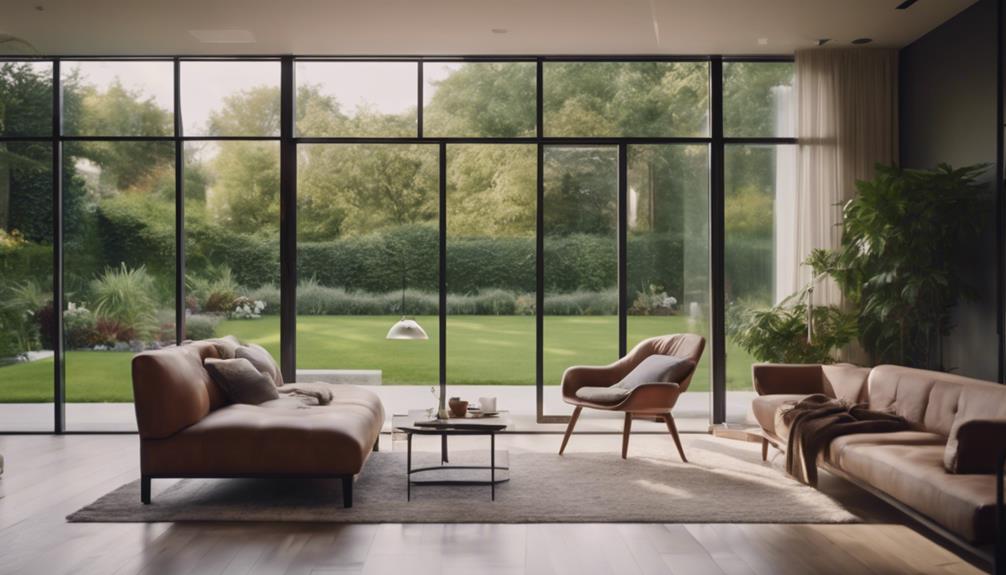
Creating effective shifts between indoor and outdoor spaces requires careful assessment of the layout to eliminate obstacles and enhance movement. Start by incorporating large glass doors or sliding doors; these reduce visual barriers and create a seamless connection between your environments.
Here are three practical tips to guarantee a smooth changeover:
- Consistent Flooring: Use flooring materials that can handle outdoor conditions while maintaining a cohesive aesthetic. This visual link makes the spaces feel unified.
- Designate Outdoor Zones: Clearly define areas for activities like dining or lounging. Confirm these outdoor zones are easily accessible from the indoor space to encourage effortless interaction.
- Incorporate Landscaping Elements: Use pathways, greenery, and other landscaping features to guide the eye. This not only beautifies your spaces but also creates a natural flow between the indoors and outdoors.
Practical Design Tips
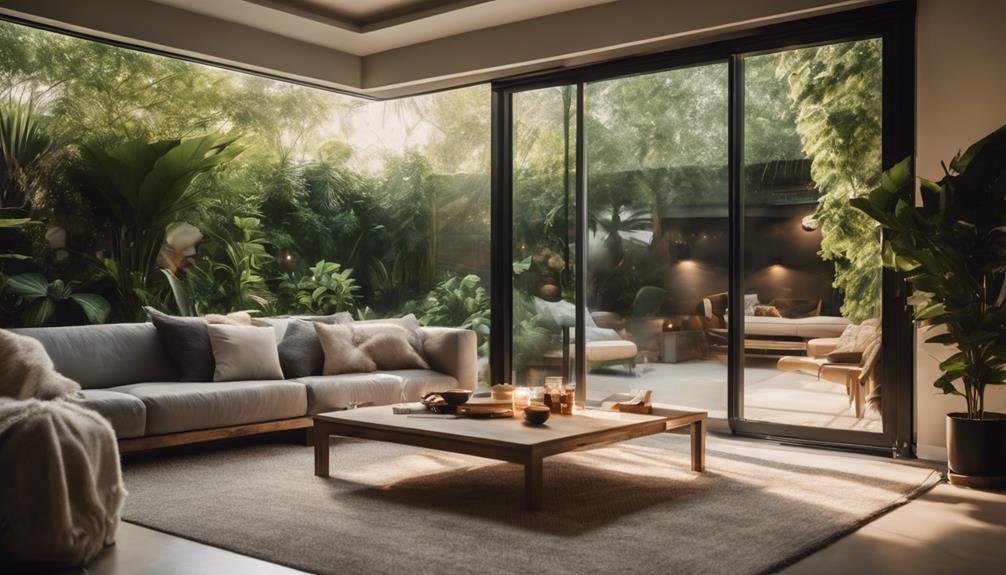
To enhance the connection between indoor and outdoor spaces, consider incorporating large glass doors that maximize natural light and expand your sightlines. These doors create a seamless connection, allowing you to enjoy the beauty of your outdoor spaces while still being inside.
For a truly cohesive design, choose flooring materials that work well in both areas, like porcelain tiles or composite decking. This choice not only provides durability but also aids in achieving that uninterrupted flow between your indoor and outdoor living spaces.
Maintaining a consistent color palette throughout is also key. Use neutral base colors complemented by vibrant accents to establish visual harmony.
Don't forget about the furniture! Opt for multi-functional pieces, such as weather-resistant sofas and extendable dining tables, that can be used in both spaces.
Utilizing Natural Elements
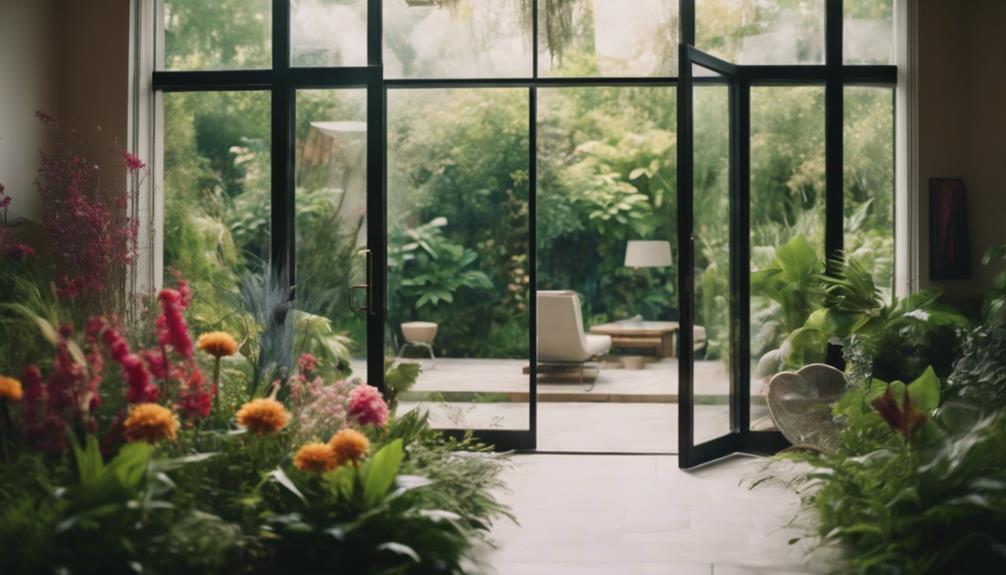
Natural elements like plants, wood, and stone can greatly enhance the connection between your indoor and outdoor spaces, offering a harmonious design that celebrates nature's beauty. By incorporating these elements, you create a cohesive design that promotes indoor-outdoor living, making your home feel more expansive and inviting.
Here are three ways to utilize natural elements effectively:
- Incorporate Large Windows: Use large windows to bring in natural light and provide stunning views of your outdoor space. This visual connection helps blur the lines between inside and outside.
- Choose Earthy Materials: Opt for materials like wood, rattan, and natural stone in your furniture and decor. These earthy tones resonate with both indoor and outdoor settings, fostering a seamless aesthetic.
- Add Indoor Plants: Incorporate large indoor plants, such as Fiddle Leaf Figs or Boston Ferns, to bring a lush feel indoors. These additions not only enhance the aesthetic but also create a vibrant atmosphere that mimics the outdoors.
Embracing natural elements in your design will help you achieve a serene and cohesive indoor-outdoor living experience.
Enhancing Connectivity
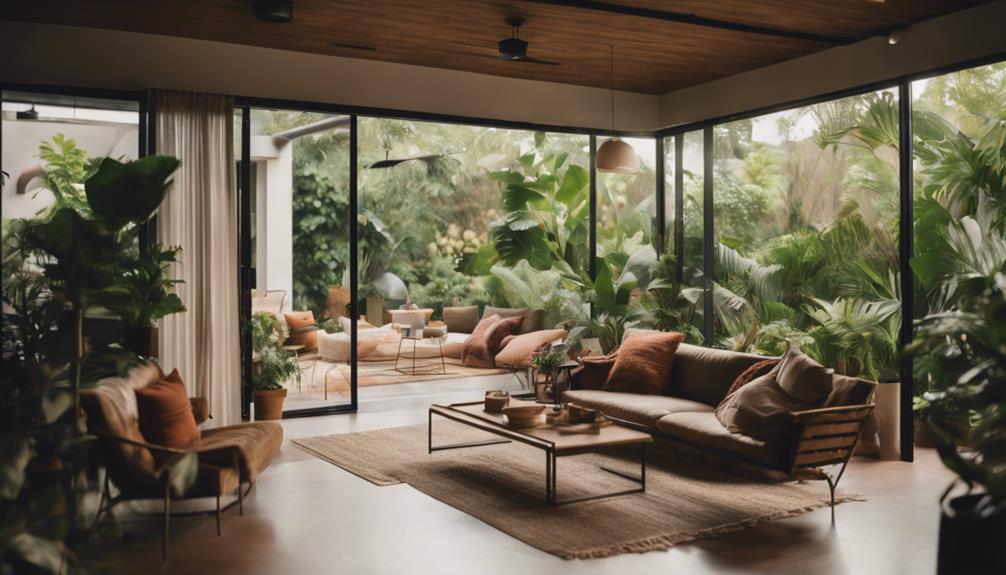
Enhancing connectivity between indoor and outdoor spaces involves thoughtful design choices that promote effortless movement and visual harmony. Start by installing large glass doors or bi-fold doors, providing unobstructed views and easy access. This creates a seamless connection, allowing you to navigate smoothly between your indoor and outdoor environments.
Next, consider using consistent flooring materials, like porcelain tiles or natural stone, to visually unify both areas. This choice reinforces the flow and eliminates any sense of separation. Incorporate natural elements, such as greenery and landscaping, to guide the eye from inside to outside, effectively bridging the two spaces.
Additionally, maintain a cohesive color palette across both areas. By using complementary colors and textures, you create a unified aesthetic that enhances the overall experience of indoor-outdoor living.
Clear pathways are essential; design them thoughtfully to minimize visual barriers, encouraging effortless movement and interaction between your indoor and outdoor spaces.
Final Touches for Flow
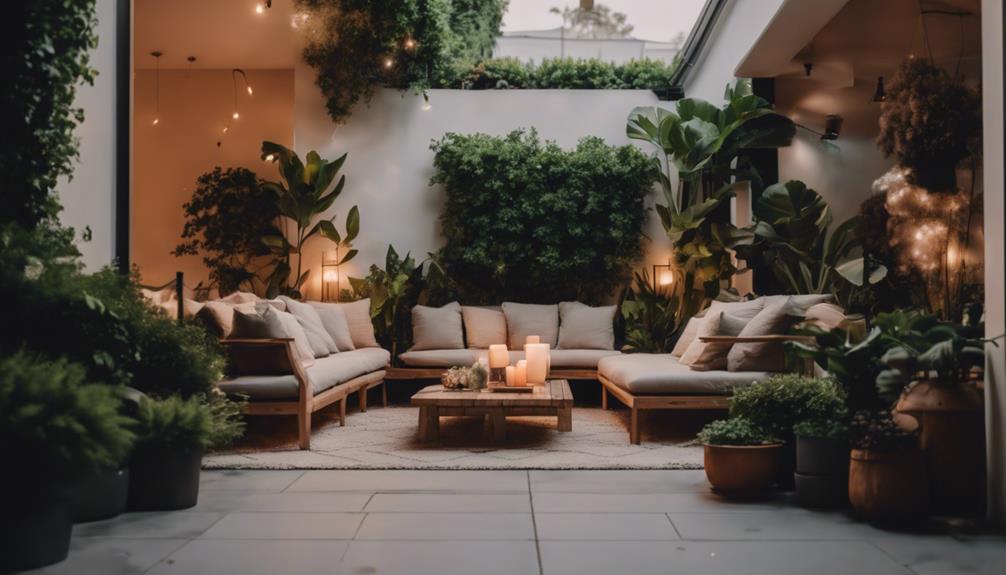
Incorporating final touches like decorative outdoor rugs and matching pillows can help create a seamless flow between your indoor and outdoor spaces. These elements tie your design together, ensuring a cohesive atmosphere that feels inviting.
Here are three essential final touches to evaluate:
- Consistent Lighting Fixtures: Use the same lighting fixtures, like pendant lights or lanterns, in both areas. This not only illuminates your space but also maintains a unified aesthetic, making your shift smooth after dark.
- Landscaping Features: Introduce soft landscaping features, such as potted plants or small trees, at the entry points. These natural elements bridge the indoor-outdoor gap, enhancing the overall experience of both spaces.
- Water Feature: Installing a water feature near your outdoor area can create a serene atmosphere. The soothing sound of flowing water enhances the connection between indoor and outdoor, further integrating your spaces.
Frequently Asked Questions
How Do You Link Indoor and Outdoor Spaces?
To link indoor and outdoor spaces, use large glass doors for easy access, maintain consistent flooring, and create a cohesive color palette. Add greenery and strategic openings to enhance the connection and flow between the areas.
How to Create Indoor/Outdoor Flow?
To create indoor/outdoor flow, use large glass doors for access, select consistent flooring, maintain a cohesive color scheme, incorporate multi-functional furniture, and enhance spaces with greenery. These elements unify your environment beautifully.
How to Create an Indoor Outdoor Living Space?
Creating an indoor-outdoor living space transforms your home's vibe. You'll feel connected to nature by using consistent materials and colors, maximizing natural light, and designing cozy zones for relaxation and dining. It's a game-changer!
How Do You Maximize Small Outdoor Space?
To maximize your small outdoor space, utilize vertical gardening, choose weather-resistant furniture, and incorporate multi-functional pieces. Use mirrors for depth and tiered landscaping to define areas, ensuring a stylish and functional environment for relaxation or entertaining.
Conclusion
You'd think creating a seamless flow between indoor and outdoor spaces is as easy as opening a door, right?
But it's all about the details—like choosing the right flooring that magically disappears between the two worlds.
So, as you blend nature with your cozy interiors, remember that a few well-placed plants can work wonders, and that the perfect lighting will make you forget where the indoors end and the outdoors begin.
Enjoy your new harmonious haven!
-

 Vetted2 months ago
Vetted2 months ago14 Best Personalized Father's Day Gifts for Your Husband – Show Him You Care
-

 Alfresco1 month ago
Alfresco1 month agoAlfresco Stacker Doors: Seamless Indoor-Outdoor Living!
-

 Craft and Textiles3 months ago
Craft and Textiles3 months ago15 Best Places to Buy Appliances for Your Home – Top Retailers Reviewed
-

 Decorative Throws3 months ago
Decorative Throws3 months agoIs It Better to Dry Clean Blankets?
-

 Tableware and Dining Accessories3 months ago
Tableware and Dining Accessories3 months agoWhat Is the Meaning of the Word Tableware
-

 Tableware and Dining Accessories3 months ago
Tableware and Dining Accessories3 months agoWhat Is the Hindi Meaning of Tableware
-

 Craft and Textiles3 months ago
Craft and Textiles3 months ago15 Best Cordless Mowers for Effortless Lawn Care – Top Picks of 2024
-

 Yarn3 months ago
Yarn3 months agoIs Yarn Natural or Manmade? Unravel the Truth























